Part One: Ho Chi Minh City
For those who may be new to our blog, Rebecca’s entries are in italics; mine are in plain text.
We touched down at Ho Chi Minh Airport after having dived into a low layer of grey clouds. We got a cab that drove us to our Airbnb rental in what turned out to be a new, glitzy side of the city just across the Sai Gon River from the central business district. Only about one kilometer from the Tran Hung Dao central banking district, (Tran Hung Dao being a 13th Century military leader who repelled the Mongols). There is no way to get there by walking less than about six kilometers, unless walking dangerously on a busy freeway style boulevard or under the new Ham Thu Thiem Tunnel. The building is tall and made of glass and marble, not quite what I expected. When trying to find a place for us to rent for eight days, I was attracted to the amazing view of the city and the price, under $70 a night including Airbnb fees, cleaning, etc. The place was labeled, “Modern minimalist decor with a fantastic view” On the map, the complex looked like a nice neighborhood just across the river from the busiest part of the downtown.
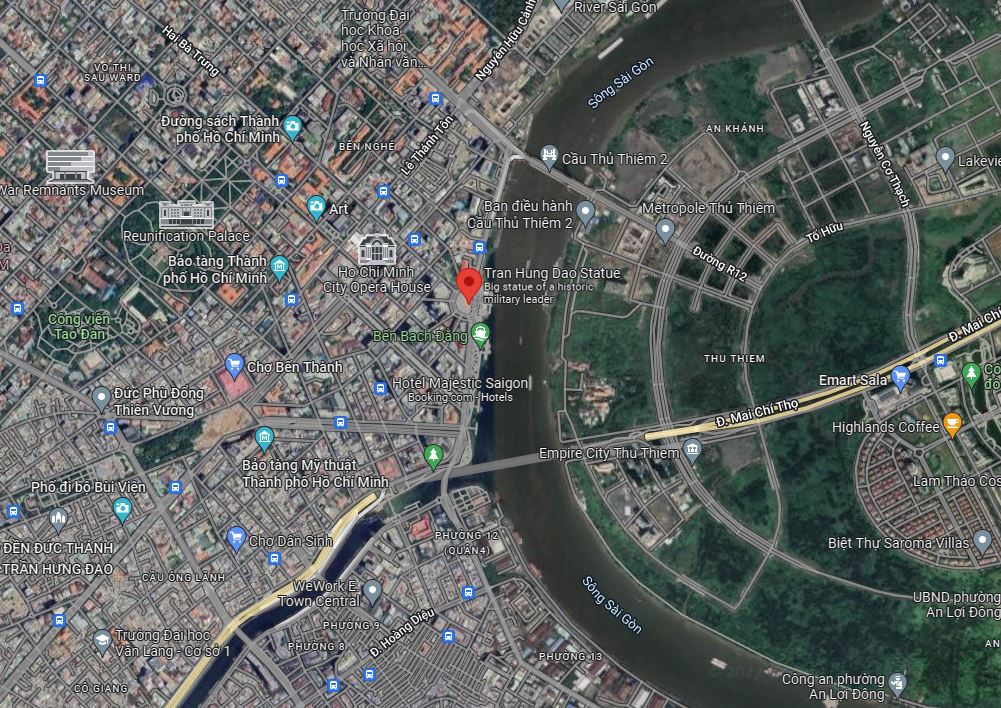
But more than anything, on the Airbnb platform I enjoyed communicating with Tin, the owner of the apartment, before we made arrangements to rent with him. He had agreed to hang out with us when we arrived, and he sounded like someone who would be interesting to know.
Our place was in an apartment 15 floors up in a 30-story building. We didn’t realize that we were out of town. It is modern (not even two years old) and sleek and the interior was all white with shiny marble floors. The lighting is bright overhead sculpture chandeliers. Right now, I am sitting on the miniscule balcony, writing on a table that is too low for the stools. But I look out through the twin apartment that are next to this one, over the river to the skyscrapers of HCMC. It has a good view. I can also see part of a highway below me where dozens and dozens and dozens of motorbikes buzz past like a swarm of bees. Cars are there too, but I’d say one car to every 20 bikes.
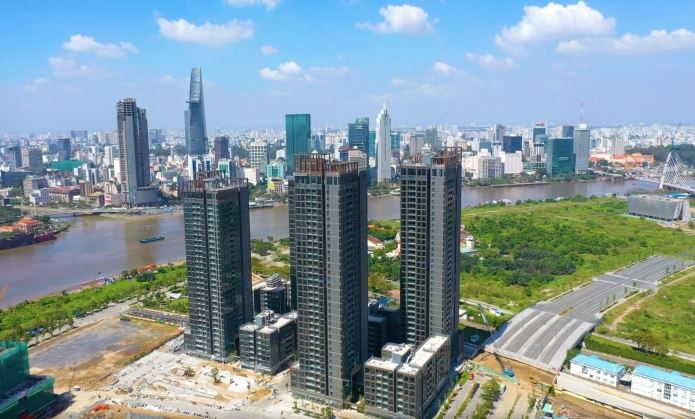
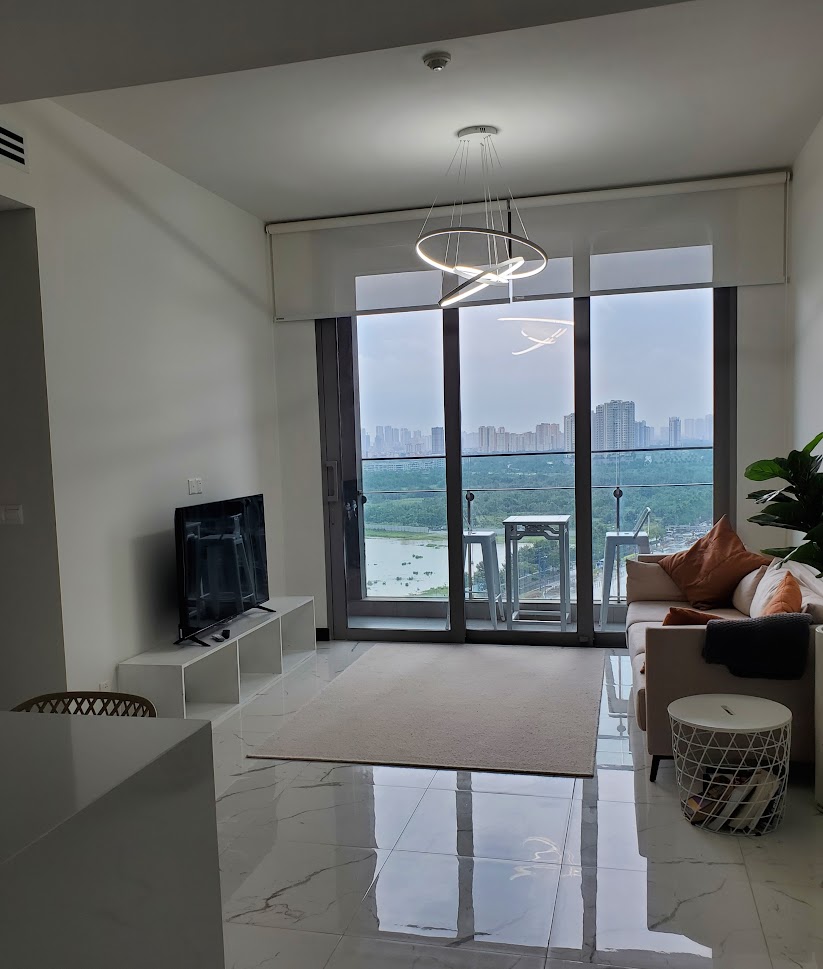

Tin, our host, speaks reasonably good English and took time to walk with us around the campus. All these buildings are less than two years old, built to expand the footprint of the city–but not all of the infrastructure is complete, so to drive here is a bit of a roundabout way. The whole development is called the Empire and has a dozen different complexes. There are three grocery stores the seize of a large 7/11, massage and beauty shops, six restaurants, and many coffee shops. There are exercise rooms, a pool for every complex, and even ping pong. You would never need to leave the Empire.
And since we were tired from traveling, we didn’t today. We had lunch at one restaurant, eating Vietnamese food, took a nap after lunch, and did some laundry. We went out to dinner at a restaurant that Tin said they had more European food–hamburgers and such. It was on the other side of a new section, and beyond it was empty fields. We ended walking to it the wrong way, going through some muddy paths around the back of the building.
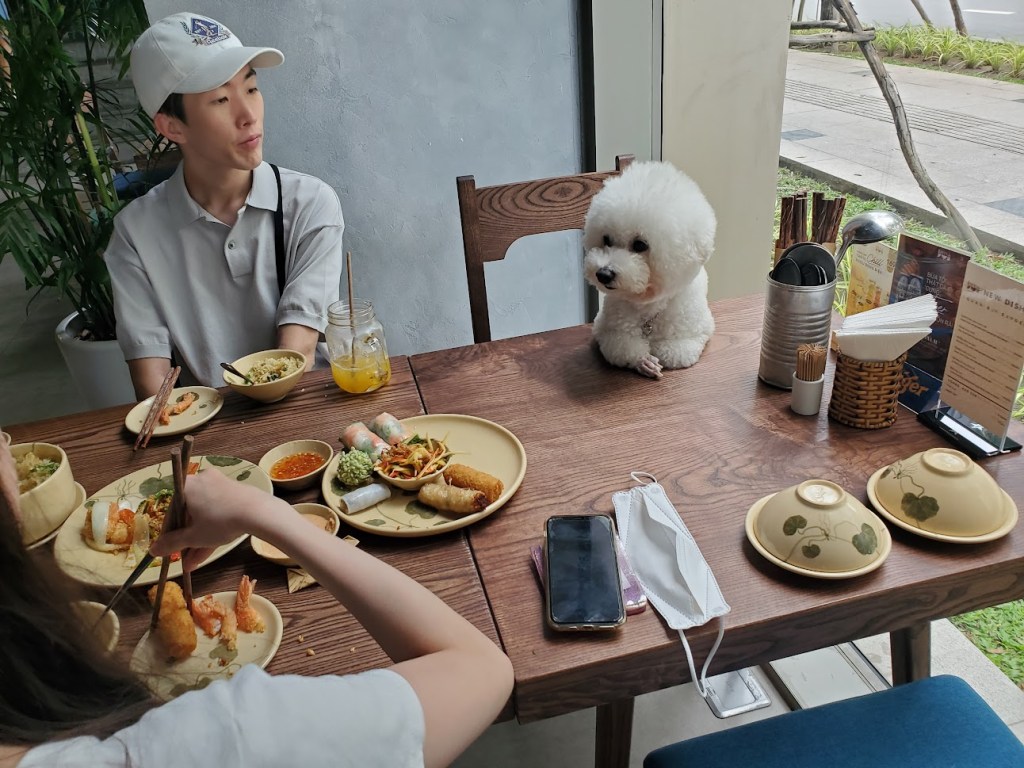
After we got settled in at our apartment, we wanted to contact our son who had just suffered fall and had been in the hospital. We managed to talk to him, and some friends and neighbors who would look in on him. Although still unsettled and worried about him, we were relieved to find out that he was recovering and that people would be there to help him if he needed anything.
Later, we invited our hosts, Tin and his wife, to come over for an after-dinner drink, but we ended up going up to their place because they had more furniture.
Tin reminds me of some Hawaiian friends we used to know from Moloka’i. He goes around in sandals and shorts and is very laid back. He is rail thin and I notice his long weathered, but still somehow delicate fingers. He looks intensely at you in the eyes for part of the time he’s talking but looks past you when he’s trying to think of what to say next.
Tin turns out to be quite an historian. Even though he was not born until after the Vietnamese War, he knows dates of each important turn in the saga that led up to the war.
Tin’s wife, Isabella, is more focused. Or maybe focused on other business. She bobs in and out of their bedroom which doubles as an office for her. She is some sort of procurement officer for a company that supplies companies like Costco with housewares made here in Vietnam. She was working for the first half hour in a morning Zoom meeting (for them) with Costco ordering agents in Texas.
During dinner, the front door suddenly opened up and a couple walked in. I must have had a somewhat surprised expression because Tin immediately explained that they rent out one of the two rooms in their apartment. They introduced us to them, then they disappeared into the second bedroom, not to be seen the rest of the evening. Obviously, Tin and Isabella may be well off, but they economize and maximize and hustle with the resources they have.
Tin is the model of a person that is a self–made success in the post war era. He told us that when he was young, (1985-1995) he remembers not having enough rice to eat. He managed to make it into a design school but had to drop out and become a carpenter because there was no design work coming his way. He started fixing up old apartments, then renting them for others. Later, bought some small apartment buildings, fixed them up and rented them as monthly rentals. When Airbnb got started, he found he could make more renting short term, but it was a lot of work with constant turnovers. Later still, he managed to buy two apartments in this new high-rise. One apartment is this two-bedroom that they share with another couple. The other is the apartment that we are in. (Tin had notified me a few days before we came to Ho Chi Minh City that he was giving us a “free upgrade.” I wasn’t sure why, but he said it had an even better view, so I said “fine.”
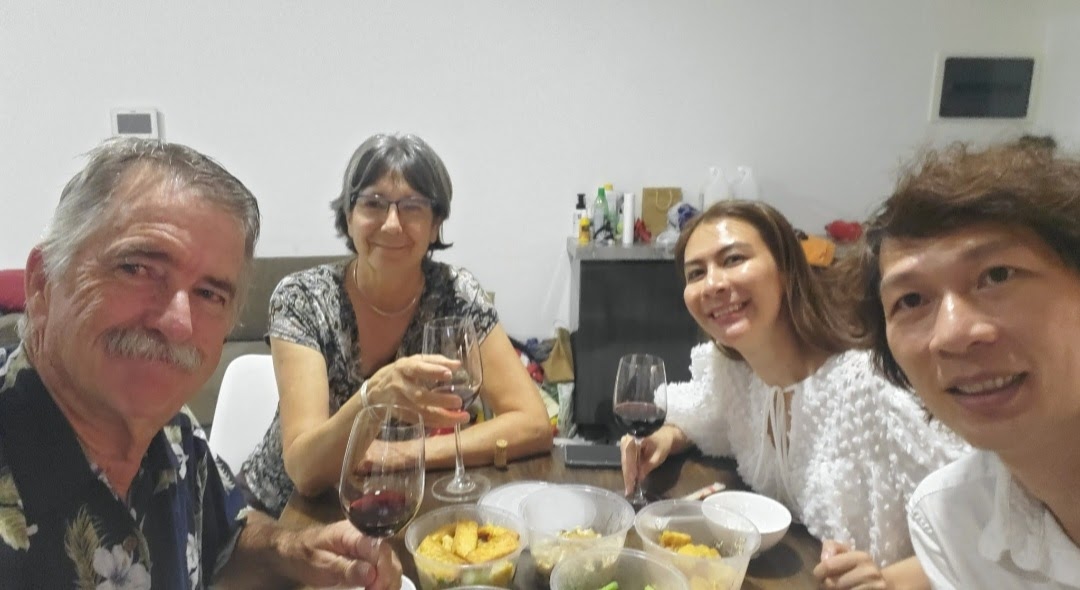
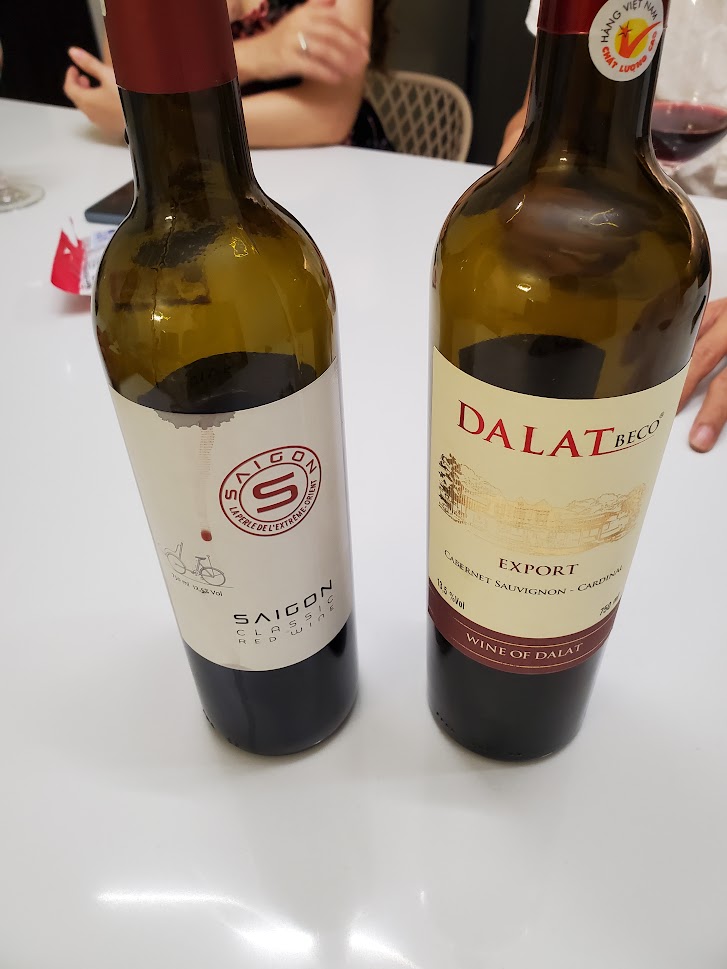
Tin and his fiancé hosted us for dinner and invited us to help them decide which wine to use for their wedding. They were to be married three weeks hence, and they had to pick which wines to serve. We gladly sampled their wines and the two bottles that we brought to the dinner. They had a white Husky-Sheppard mix called “Ivy.” It seems that these people have a thing for white dogs!
What about the one bedroom that we had originally rented, I asked him.
Tin explained that that apartment is one that he manages for a friend. There was a guest there that wanted to extend his stay, so rather than having them move, he decided that giving us the bigger two bedroom was easiest since his wasn’t rented.
I asked, if he didn’t mind, how much his two apartments in this building were worth on today’s market.
“Well with the interest rates going up, not as much as before. But today I could sell them for $500,000 US$.
“Do you own them outright?”
“What is ‘outright?” Tin asked.
“It’s when you don’t have a loan, you don’t owe a bank money.”
“Nobody would loan me money. I had to save for each place I bought. We say you own it outright if you are not making payments on it.”
“Oh, no one would lend us any money. I saved until I had enough to buy it with cash.”
So, I realized, here’s a guy who barely had enough to eat as a kid, started off with zero capital, (in a communist country at the time), didn’t go to college, but has now worth at least a million US dollars’ worth of real estate! Amazing!
We met our hosts Tin and his wife Isabel for wine. We brought a couple bottles of wine, and they had some, too. We talked until about 11pm. Isabella is kind, with a quick smile. she seems, very sweet. Tin has wild hair and a keen mind. We talked some about the war some. He had some interesting insights. He said there was no resentment, and that they really are just looking forward toward the future.
Tin and Isabelle told us that they were soon to be married. They said that they had planned a “small wedding.” Later, he sent us some photos from the wedding. Taken from their venue in the mountains 200km away, he sent the photo below of himself, Isabella and Ivy. We found out that they had over 150 people at the wedding! “That’s huge!” I wrote to him. “How did you get everyone up to the venue?”
“We rented a bus for 45 people and the rest drove. In Vietnam, that’s a small wedding,” he responded.

Over a bottle of wine, I asked Tin to tell me everything he knows about the Vietnam War.
Tin told us that first of all, when you talk about the war, here they call the “American War.”
Well, weren’t we on your side?
Well, Tin told us, it remembered as a betrayal by the South after the US pulled out in 1972, the war continued, and we were left to deal with the North by ourselves. Then there was a period of great turmoil after the war when anyone who had helped with the war was taken to “reeducation camps” for several years. Tin had family members who had been taken to one of the camps. He had other relatives that tried to escape on a boat. Conditions on the boats were extreme. Tin thought that there might have been just as many people that had died trying to escape as had died in the actual war. Things under the Communists were very tough. There was rationing and supplies were hard to get. Many were robbed by pirates and then left adrift with no food or means of power until they starved to death. Others were capsized by storms.
But people seem to be very welcoming to us as American Citizens. We don’t see much in the way of Anti-American sentiment, I wondered aloud.
First of all, Tin explained, the US soldiers were only involved for 10 years, he told us. We fought the French for 100 years. And before that, they had fought China 1000 years. So historically, the war with the Americans was rather limited.
I sensed that he still regarded us as the enemy. “We were on your side,” I reminded him.
Do most people resent the US leaving when we saw the war was un-winnable?
“No,” he said, “most people have forgotten about it. It’s been 50 years. We’re more interested in moving forward.”
Trying to give a broader perspective, Tin asked us to imagine a giant chess board. “Imagine China on one side and the US on the other. And that chessboard, that’s Vietnam.” Tin said.
“So it was a way for them to fight over territory without really fighting against each other.” I said.
“Exactly” Tin agreed. “It was a proxy war.”
I was anxious to learn about some history, especially from the Vietnamese perspective. We planned to visit the Ho Chi Minh Museum the next day, and maybe things would make more sense.
Although Rebecca and I had the feeling that this place where we chose to spend this part of our trip was not exactly our type, (too modern, too glitzy, isolated from the historic center of the city) we got the feeling that we could not have met better people that represent the new Vietnam. This couple was industrious, savvy, and adaptive with regard to the future. They had taken what was available, worked hard, and helped build a new community.
That evening, we watched the last of the big storms this season from our floor-to-ceiling glass windows. The waning of the Monsoon season was just finishing up. We got a taste of it, but only just.

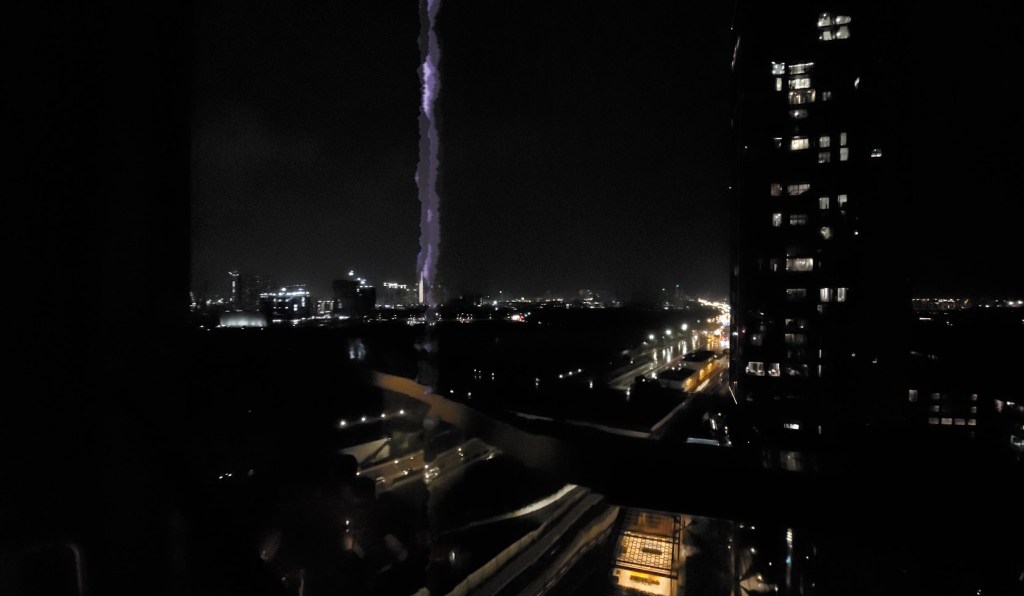
I took a cool picture during the lightning storm and captured lightening striking the tall tower across town.
Last night we had bought a few groceries–milk, coffee, green tea and cereal so that is what we had for breakfast. Woody got the App for Grab on his phone and he spent time figuring it out so we could order a ride downtown. He also signed us up for a free walking tour tomorrow.
The Ho Chi Minh Museum
Going anywhere nowadays without a phone puts you at a handicap. Everything that is ordered, read, researched, and delivered is done so by phone. Usually, even the menus to the modern restaurants are found on a QR code, and you can even submit your order ahead of time or while you’re in the restaurant to save time. Our problem is that we first have to ask to get connected to someone’s Wi-Fi.
In Bangkok, I found a “pocket Wi-Fi” for about $25, and then I had to buy a chip with some pre-determined amount of data on it. So, in Vietnam, I bought Vietnamese chip, and it seems to work with the phones here. I can use it to connect to the Internet, and I can call using WhatsApp most places. The next morning, we tried out the Grab app to get a ride into town. Though we’re only less than a mile from downtown, we’re separated by several freeways and a river. Like Uber, the car shows up on your screen, and you can watch him drive to the place of pick-up. The 15-minute ride cost less than two dollars.
The cab showed up and drove us across the river to a spot near the center. We walked along narrow and hazardous sidewalks to the history museum. It was an old colonial style building from the eighteen hundreds. I assume the French designed it. It is made of massive stone and marble and needs money to be fixed up. But there is something lovely in the decrepitude. Other people think so, too. It seems to be the number one place to have wedding photos taken. We saw at least five couples in their wedding finery, posing for their own private photographer.
The first museum we visited was Ho Chi Minh City Museum. It was an interesting collection of archeology, city origin documents, some war artifacts from the many wars up to and including the war with the Americans, and cultural artifacts. Curiously, there was also a display of wedding costumes going back a couple hundred years. And even more curious, was the fact that we saw no fewer than a dozen couples who had come there to have photographs taken inside the museum. We did not get a good answer about why they were there, but some had and entourage of photographers that made us feel like we were in their way, as we passed through the museum! Given the fact that our new friends, Tin and Isabelle were soon to be married, it felt like a theme for our visit to HCMC.

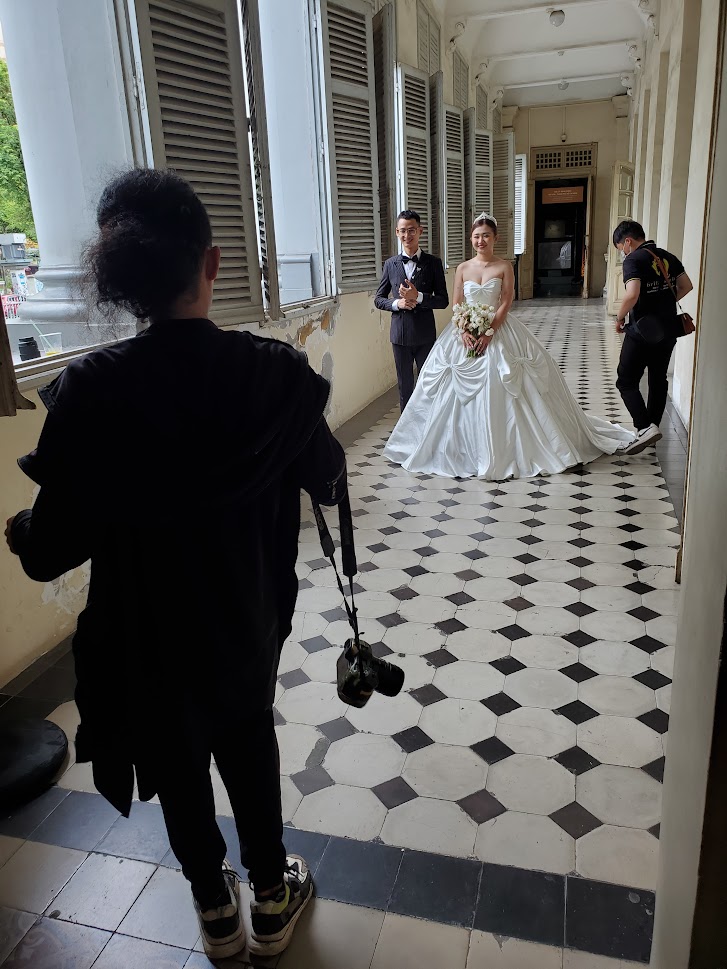

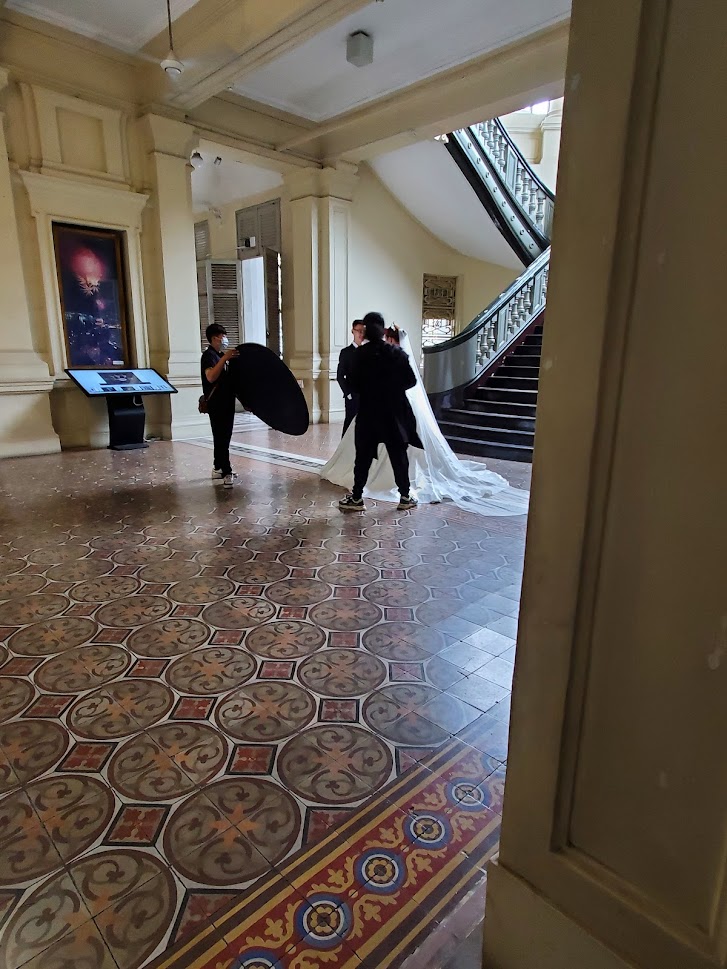

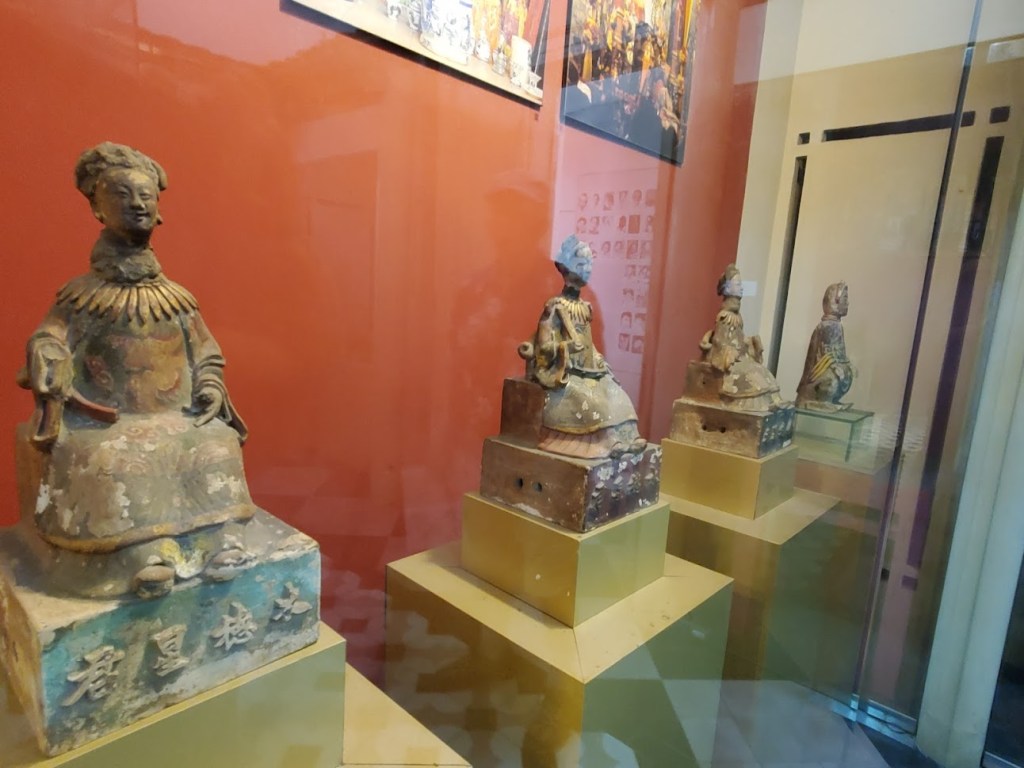

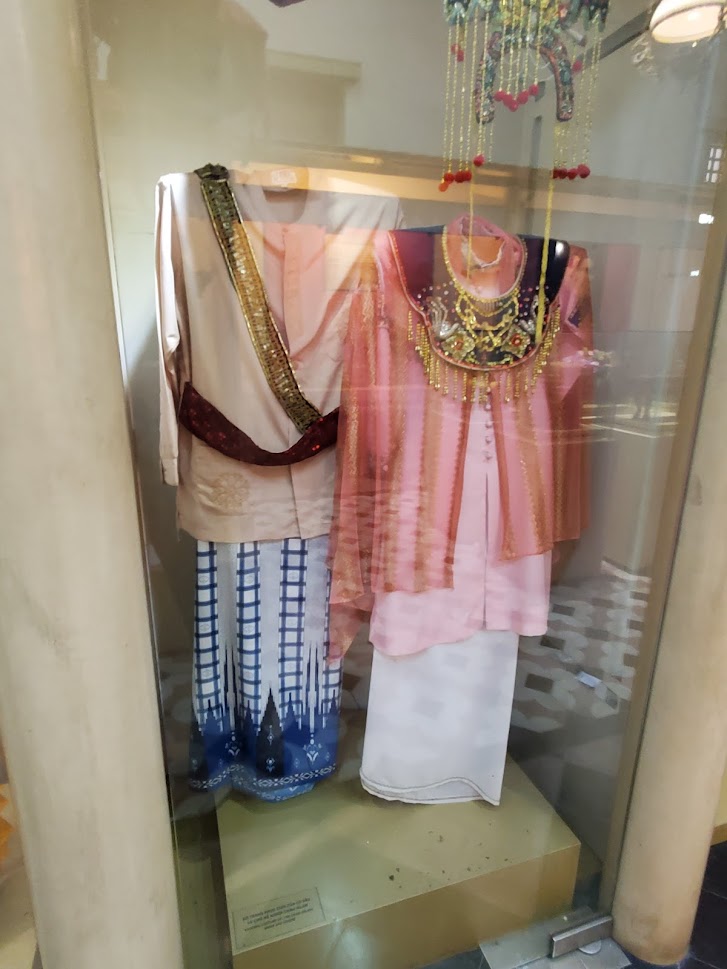
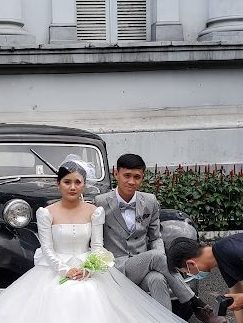
There were cool things to see–old looms, wedding costumes from around Vietnam, the custom of betelnut and how it is connected to the hill tribes and their wedding ceremonies, an old hand pulled firetruck, as well as itemss having to do with the war.


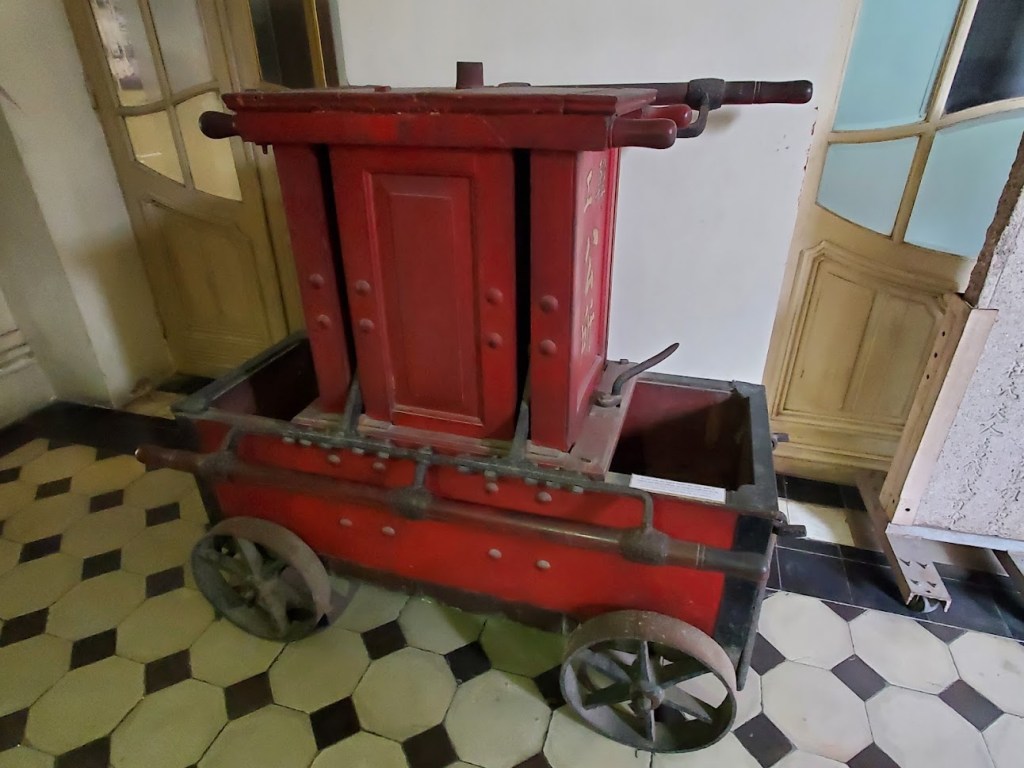
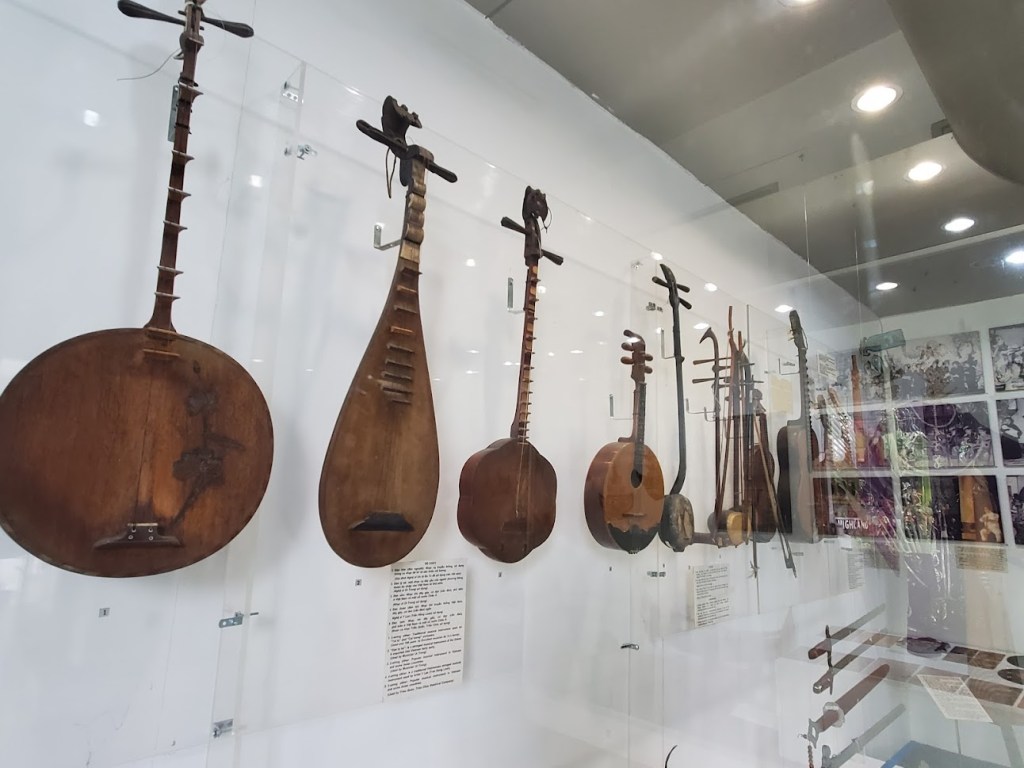
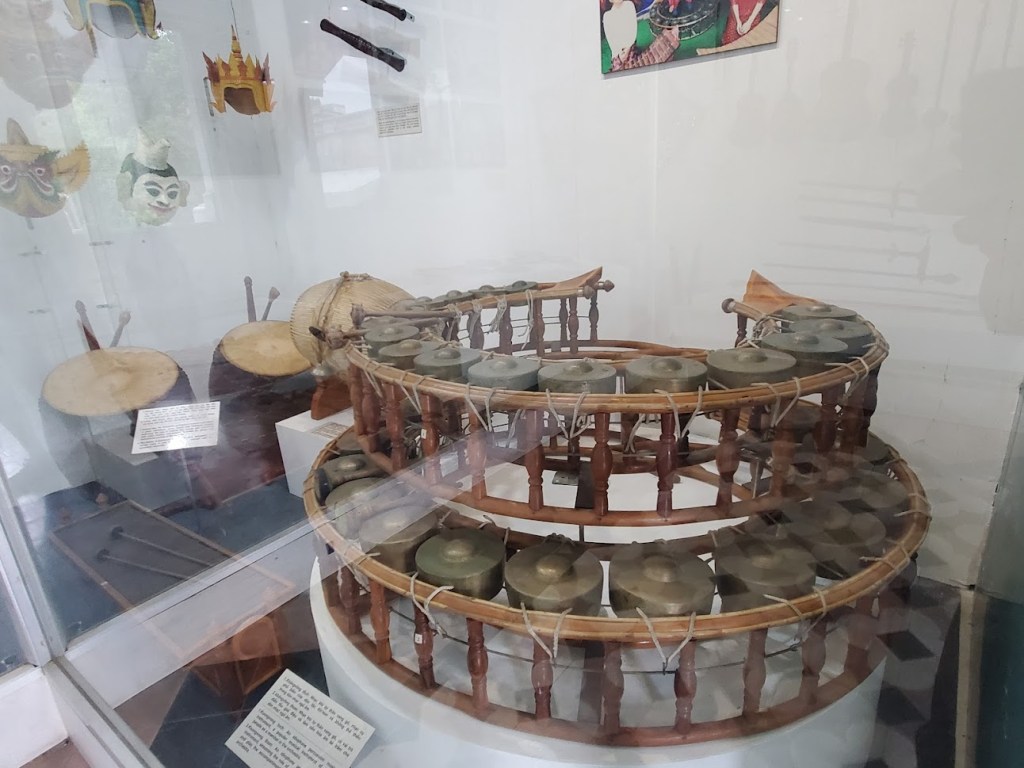
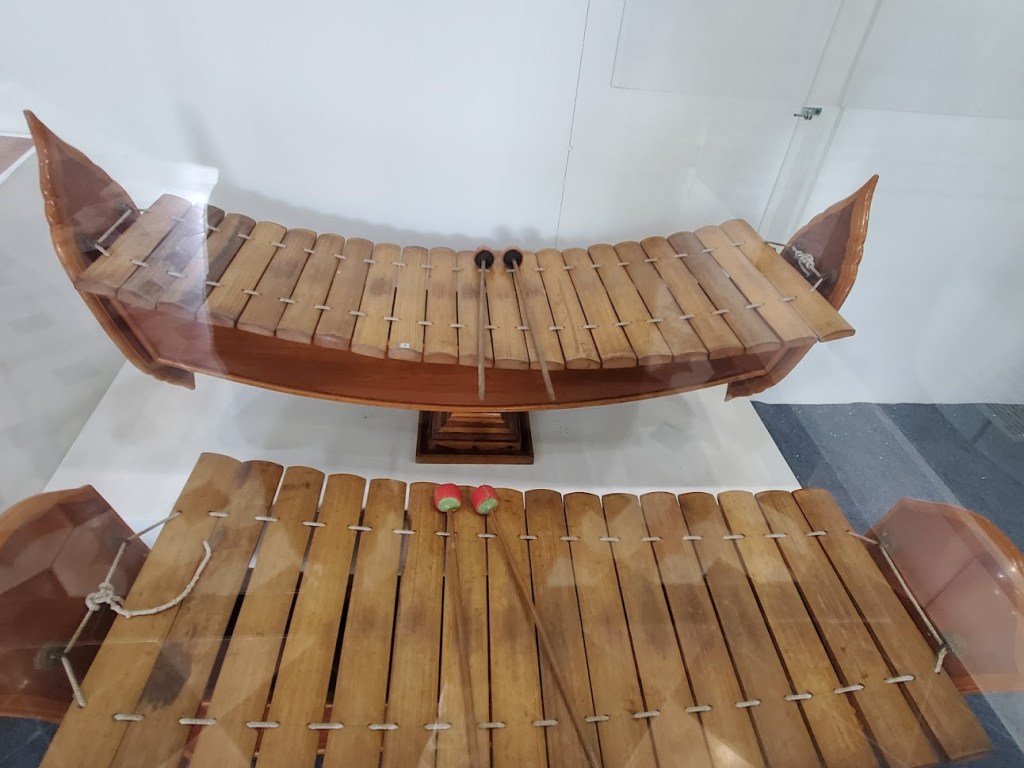
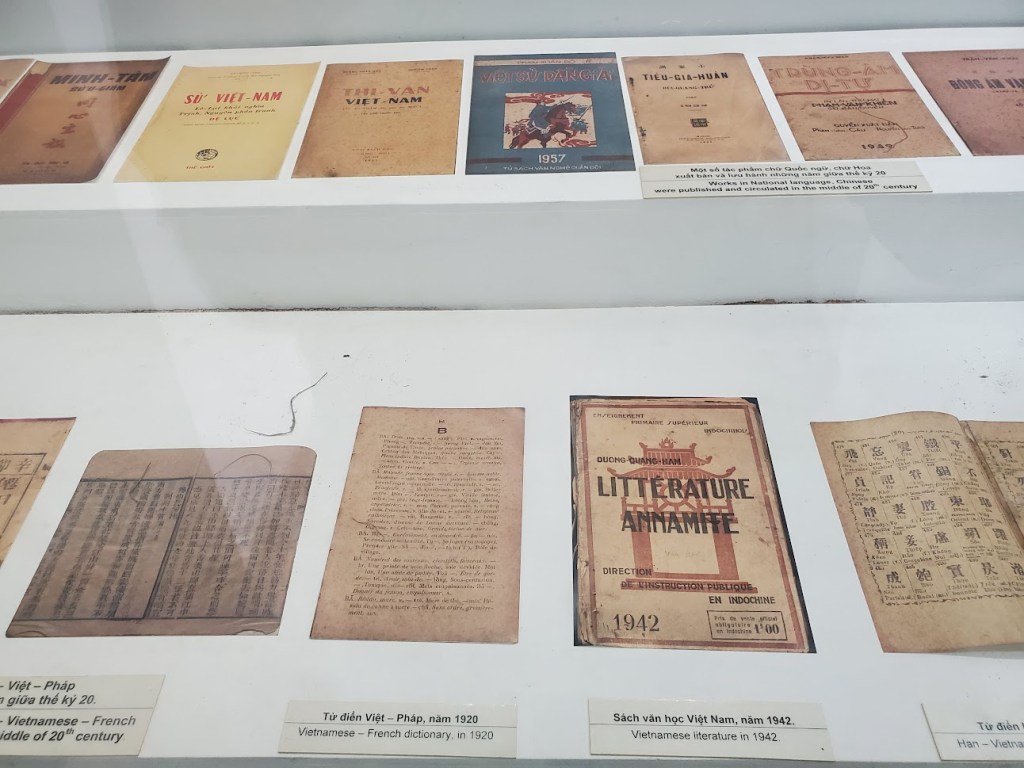
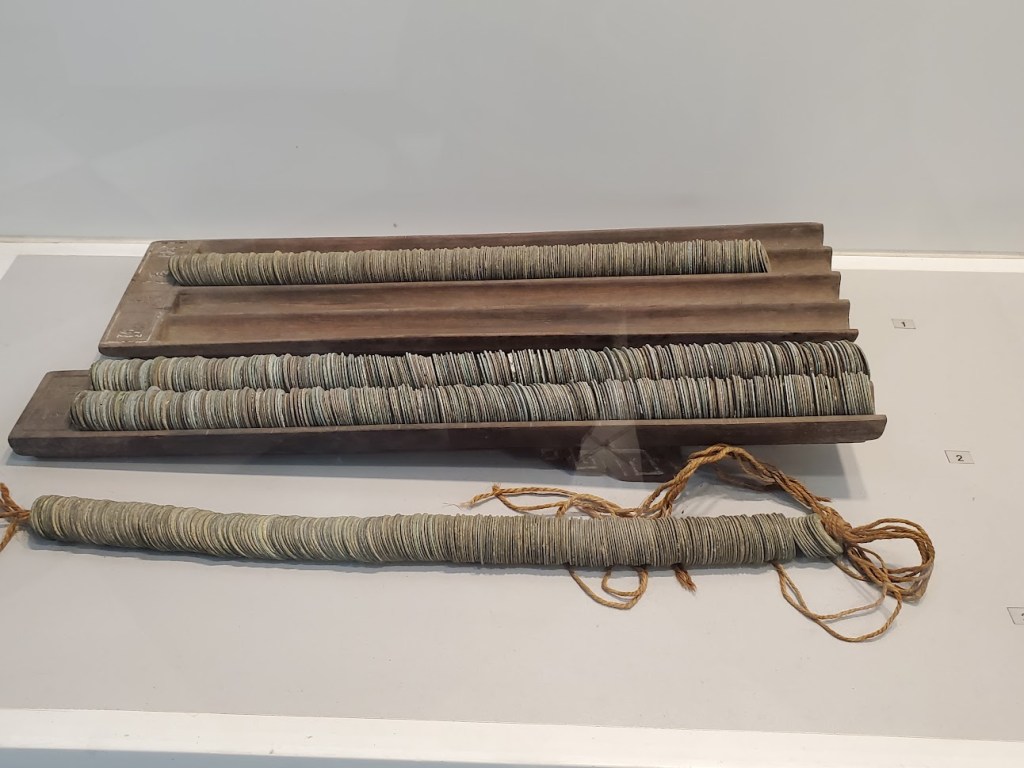
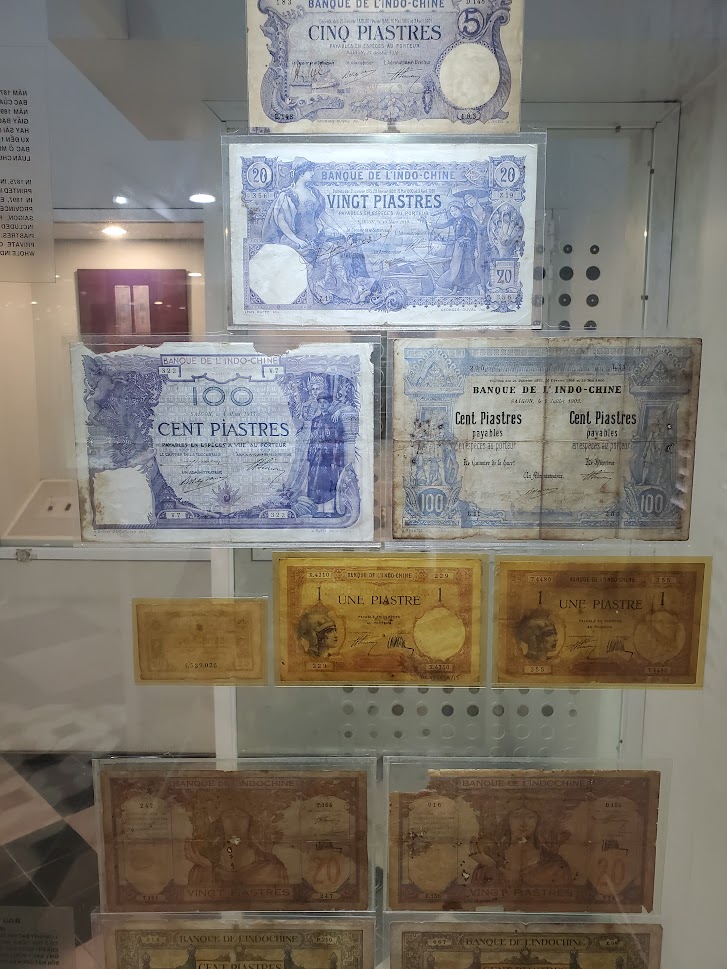
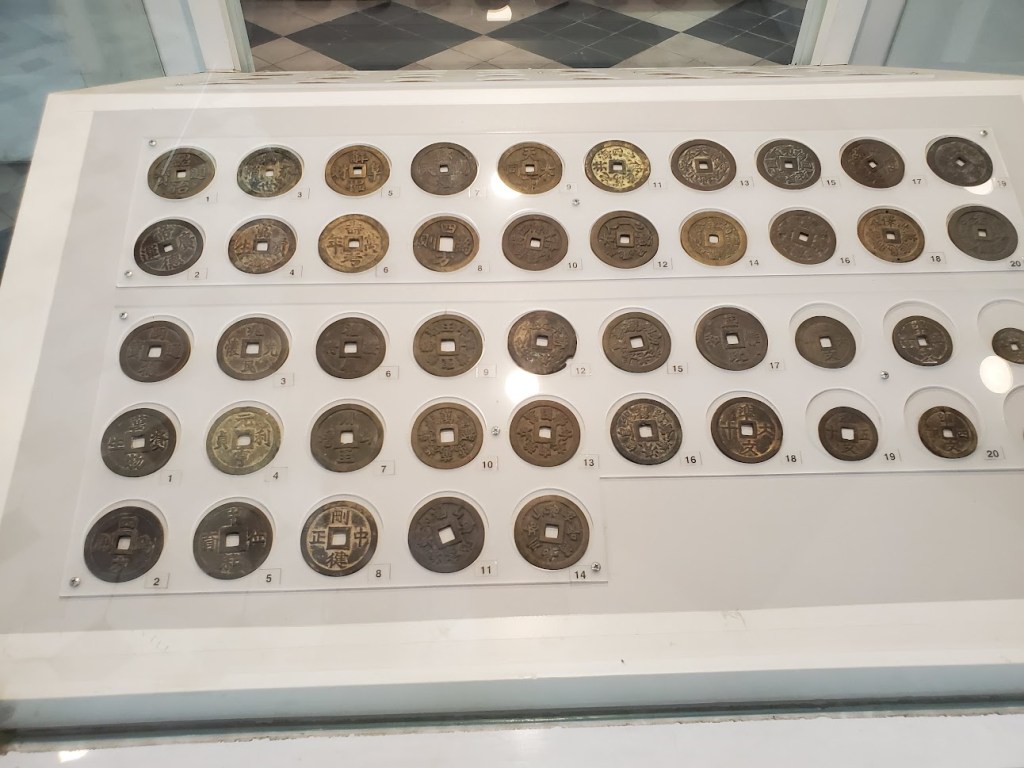
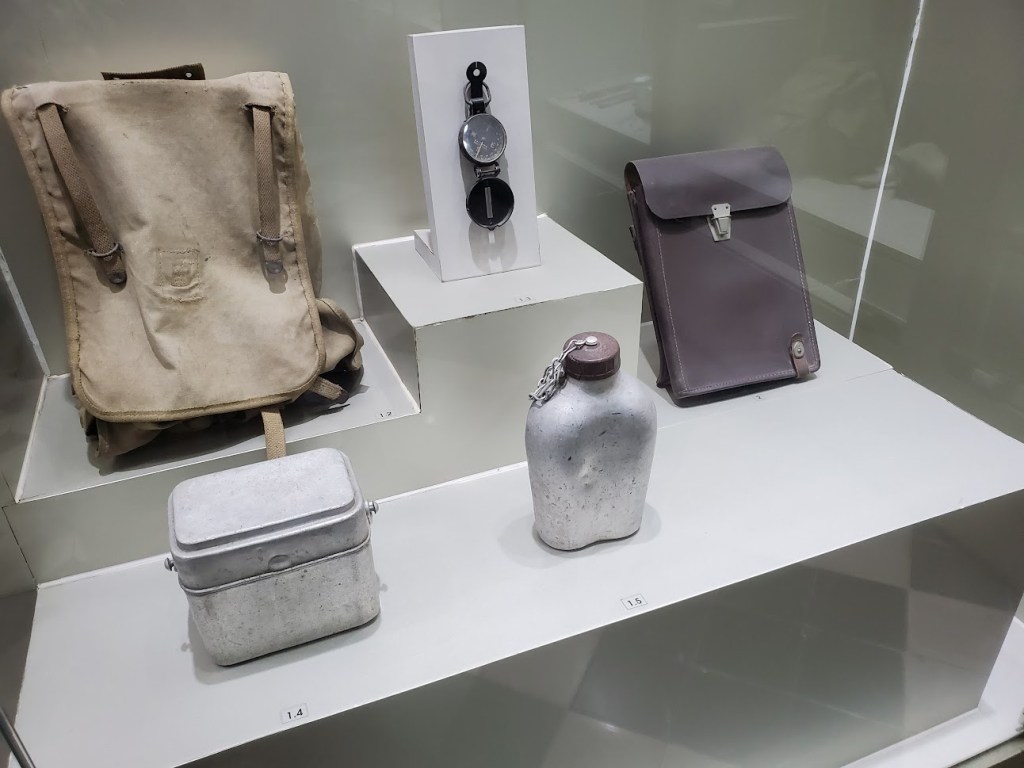



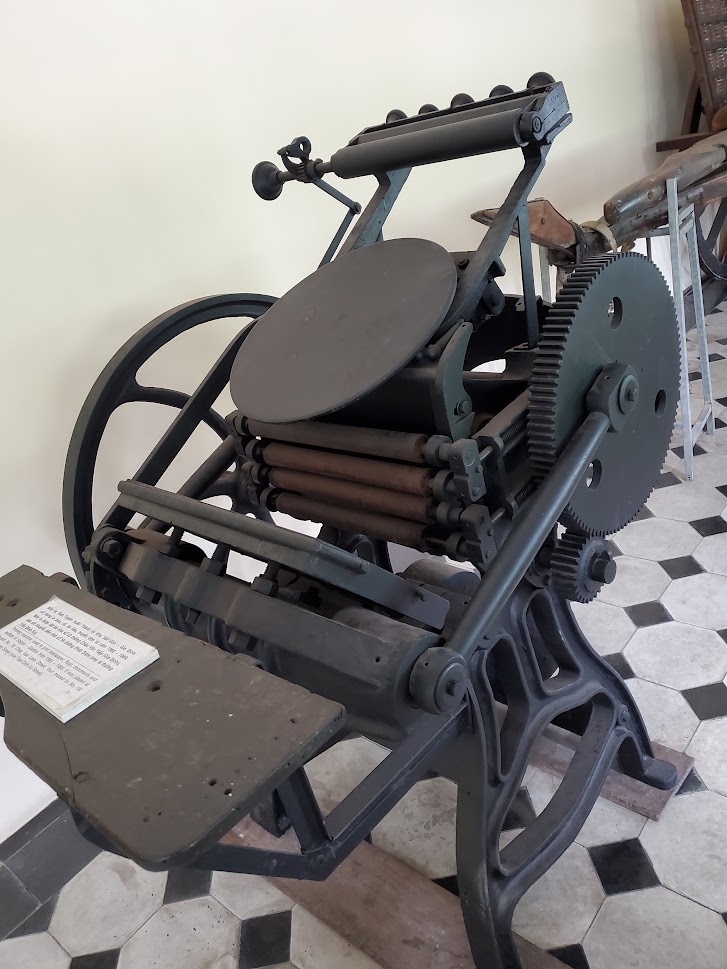
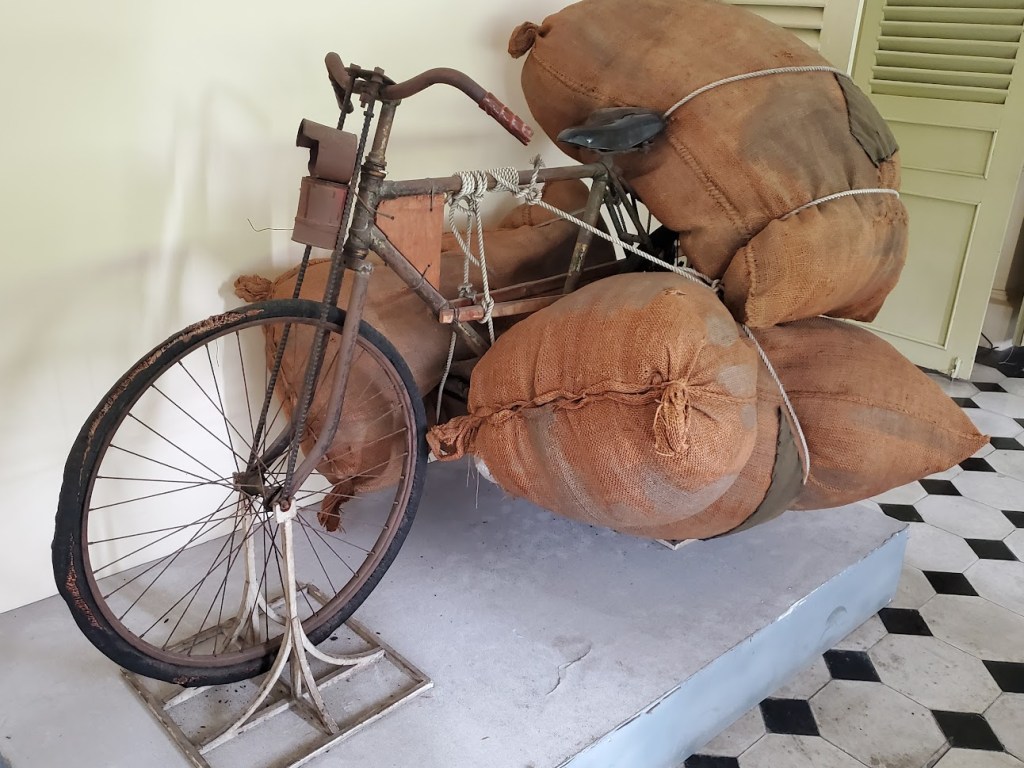
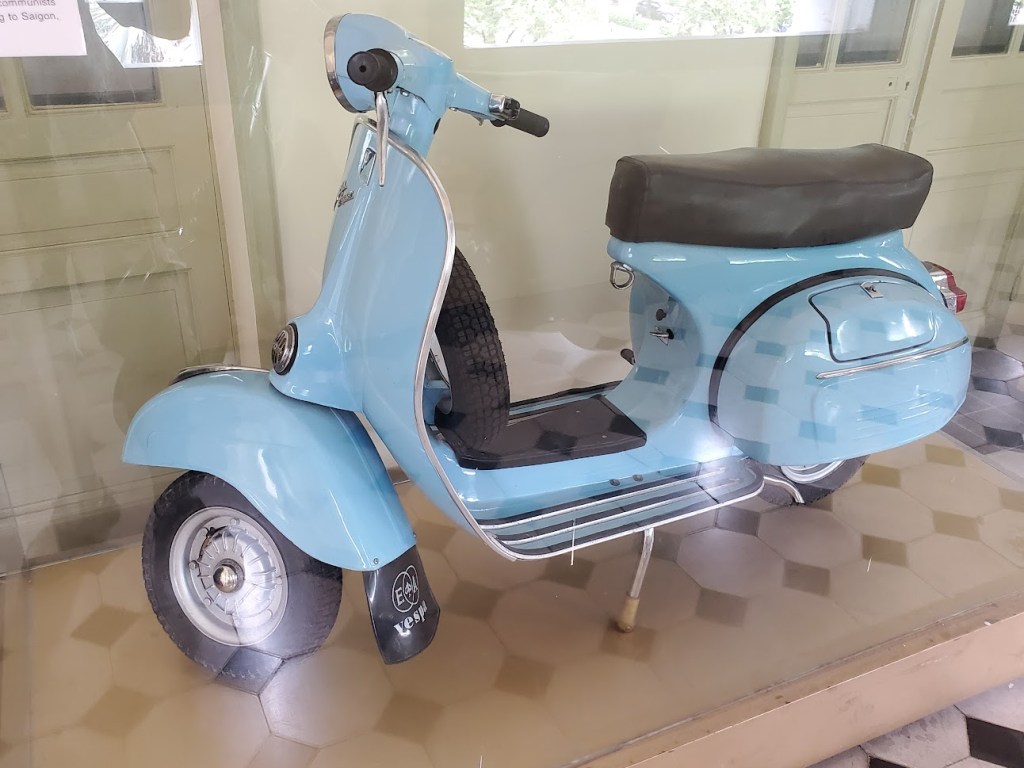
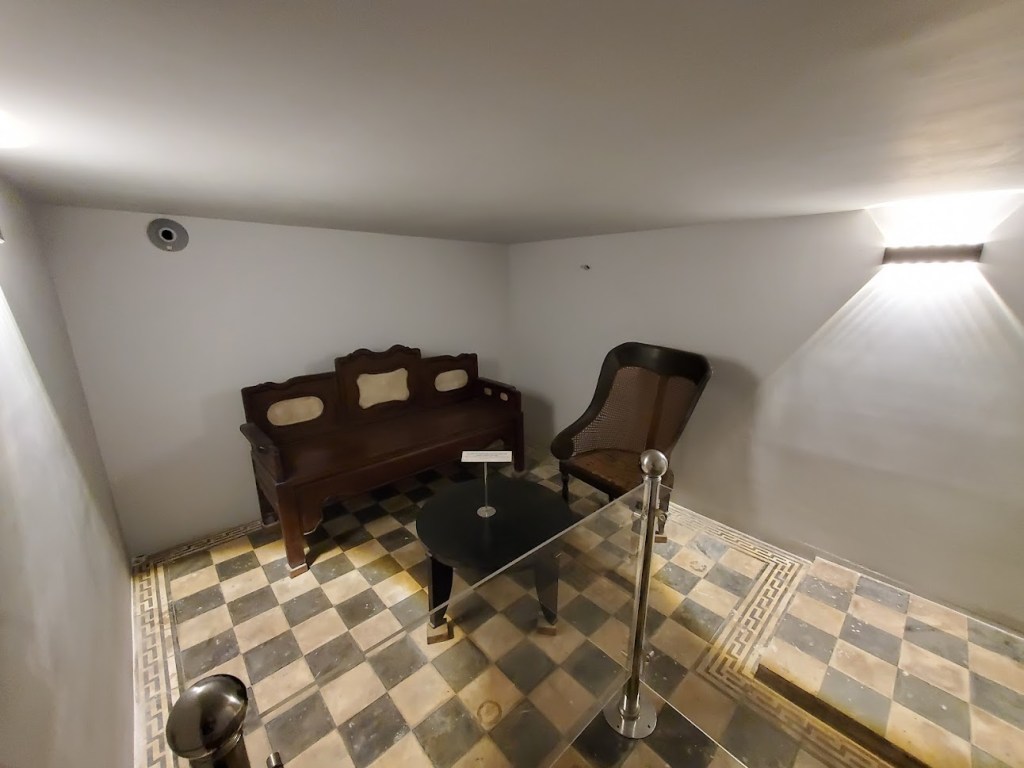
It struck me as we were leaving, after seeing the charming wedding costumes both men and women had dressed back in the day, and then seeing all these couples in their western garb–white bridal gowns and tuxes, that is a huge shame Western culture has taken over so much of the world. The variety of the old ways was much more creative. Why has this happened?
Outside the museum, we got scammed. New tourists, that we are. A man carrying a pole across his shoulders with a cooler on side and a basket of coconuts stopped us to talk. He seemed friendly and said he was heading back home and gave us a coconut to drink–intimating it would not be good to take home and offering it as a gift. He gave Woody one too. Then he asked us for $150,000 Dong as we were drinking, which is about $6 dollars for the two. Buyers beware! Then another man wanted to fix Woody’s shoe. He said it need glue. We said no and walked away.
I came away from the museum thinking that this is a normal city. Its past is complicated, layered, various eras that have been woven into a complex background for the modern city we see here. And the story that I came to unfold is not easily visible. For me, the word Vietnam cannot be spoken without an echo of the war. It was, for me, a touchstone for decisions I made as an 18-year-old. I decided that I would go into war, if my lottery number came up, but I would ask to be a medic, or some other non-combative role. “Conscientious Cooperator,” a draft application so unknown that the movie Hacksaw Ridge used it as an enigma within the storyline. The protagonist “found a niche in the law” where he could serve his country without carrying a weapon.
That was the niche I found as well. In my teens, I researched the Baha’i Faith, and I found a recommendation to file for Conscientious Cooperator status, a decision that had my parents befuddled. Was I going to go to war? Was I going to college? And exactly what was I “conscientious” about?
I had read and watched the news. I heard that the Paris Peace Talks were stalled. I heard that the US was still sending new recruits to maintain levels of troops to assist with the “cleanup” while there was carpet bombing taking place. All the while, the war had spilled over into Cambodia to interrupt the supply line from the north. I had heard about Lieutenant William Calley, whose over-enthusiasm led him to massacre 80 civilians cowering in a ditch. He was later committed to life and dishonorably discharged, only to be granted amnesty by President Nixon later on. I had heard about the US use of “agent orange” and mass spraying of the countryside to defoliate the jungle and expose the supply routes from the North. While I did not fully understand it, I felt that this war had no clear mission, and that I did not believe that our military might, and personnel were helping.
In the spring of 1971, filed papers with the Selective Service to go, if selected, but not as a combatant. As it turned out, my draft number was 321, a number that was never reached. The Selective Service announced, while I was working my first summer job as a firefighter after graduation, that they would not take anyone with a draft number over 125.
But I had staked out my philosophical ground. I had made my mind up. I had officially filed papers to say that I would not fight. I did not suffer the horror of serving and watching my buddies die or suffer injury myself. But the decision and the experience left its mark on me.
Now, 50 years later, I was in HCMC, formerly Saigon, to see the places that were on the news, and to meet people that might remember those times and fill me in on what really happened. And this city just seems like it has amnesia. Where is the mark left from the war? I was determined to find some people or evidence of the war.
After the museum we walked around, just looking. We ended up at a park which was green and clean. We used our phone to see how to get to the cathedral and the post office. The cathedral was nearby but covered in scaffolding and very closed. It is a tall red brick building with two spires at the front called Notre Dame. We didn’t stop.
The post office was a cross the street. It is a lovely building built in the French style in about the year 1886, I think. It has a cavernous hall, lovely dark wood counters, and a light and airy quality. I bought some post cards and Woody stood in line for stamps.


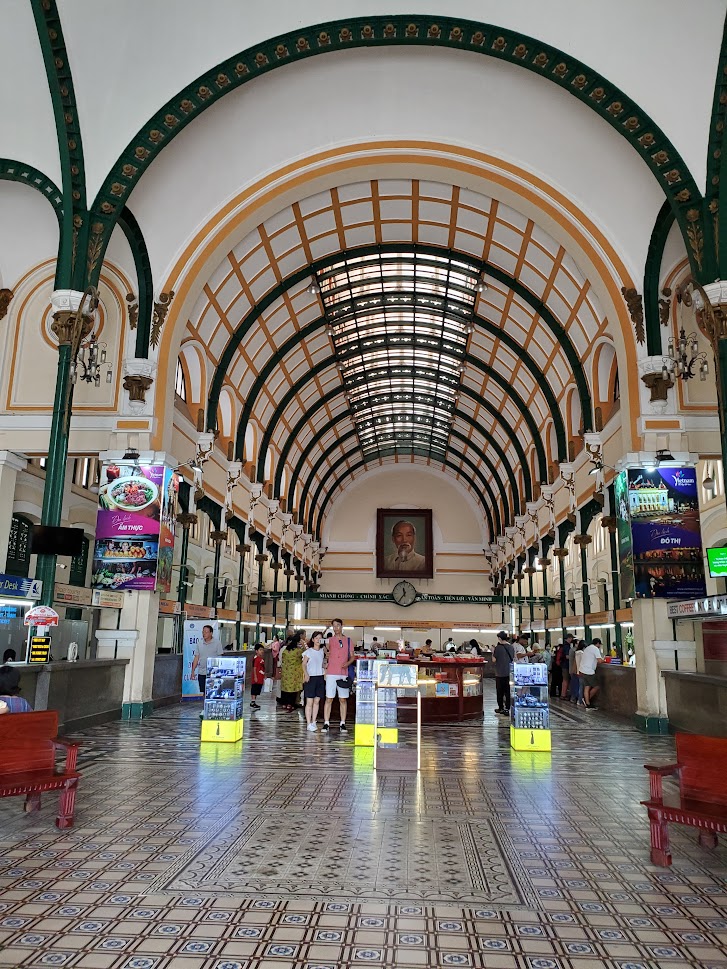
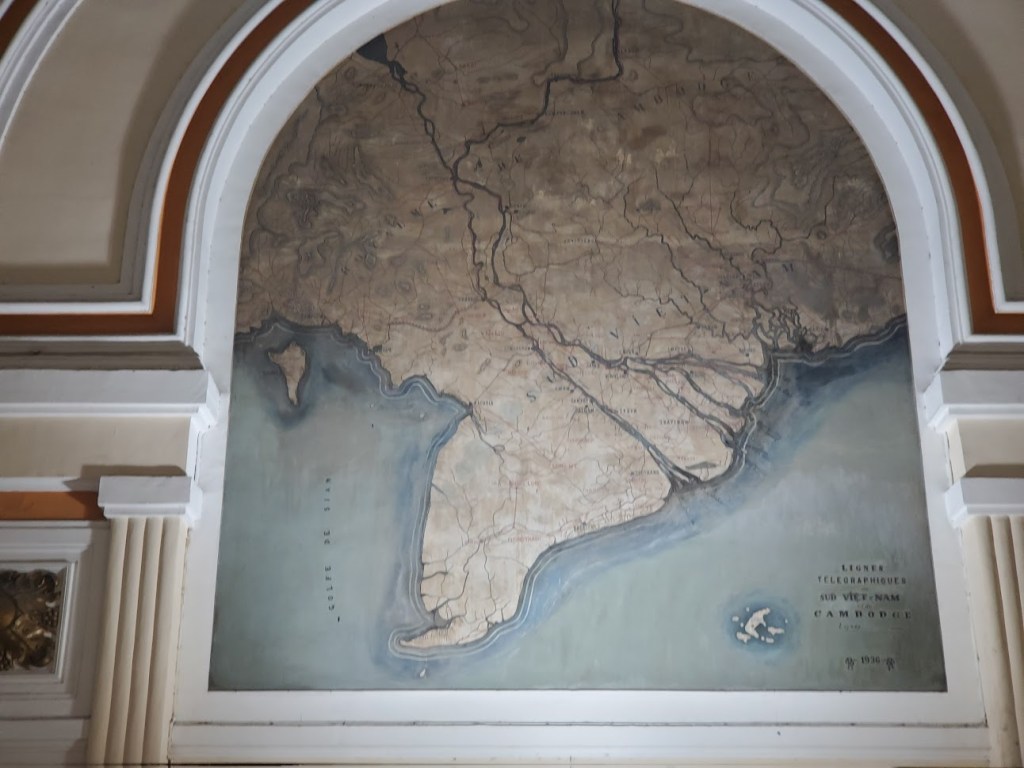
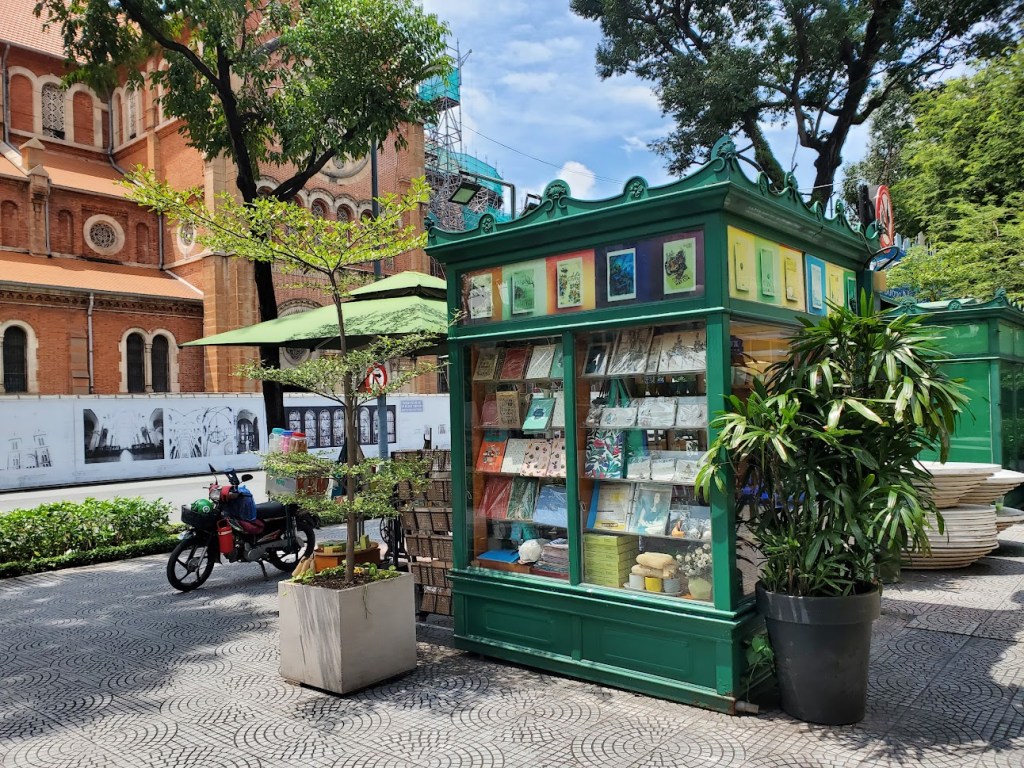
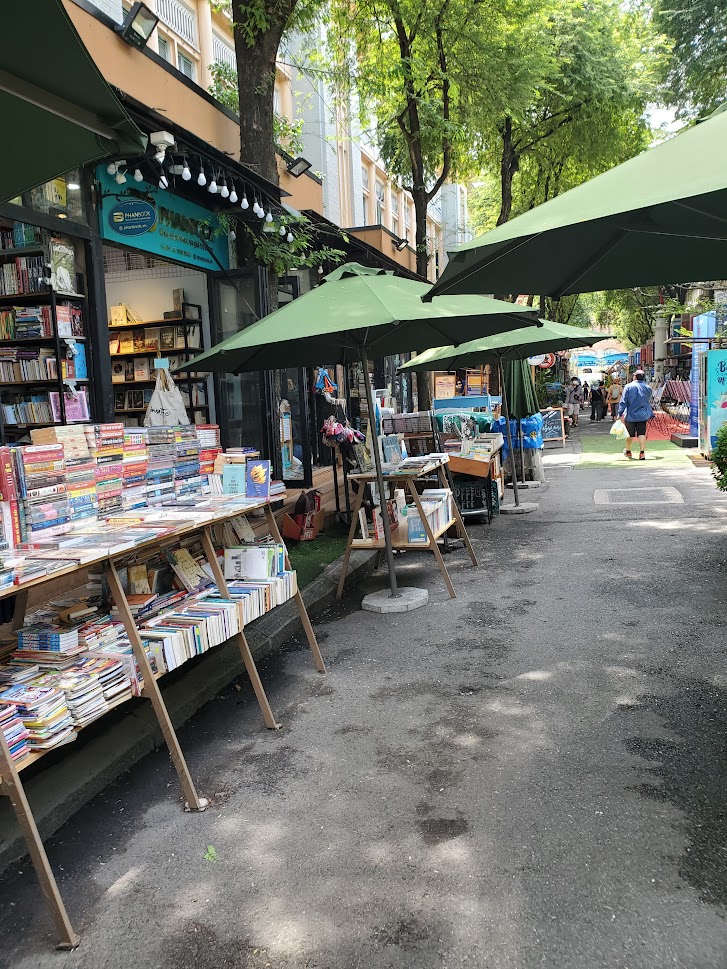
Outside, we walked down past some green book stalls that reminded me of Paris and that was a start of a lovely lane full of book stalls and cafes.
I had read in my guidebook about a restaurant called Chia Hoa. They even served krupook. We found it down an alley. The food there was great, and I found that they had have a cooking school on site, so I signed up for a class on Sunday at 7am, after we get back from Hanoi.
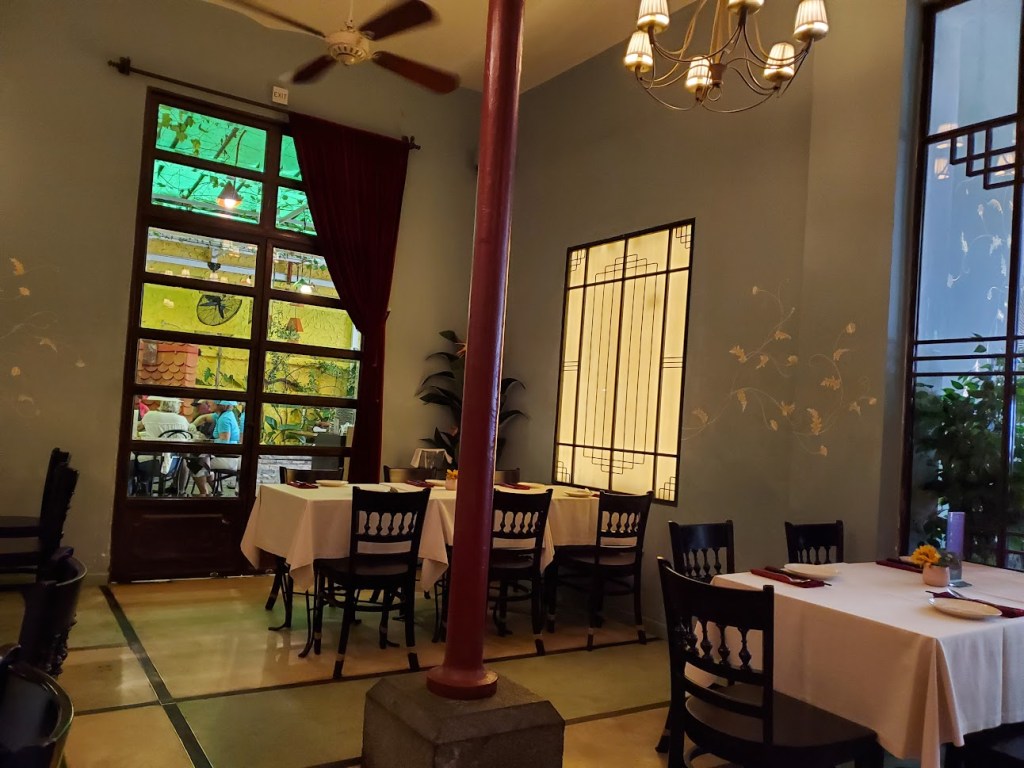
We walked to a busy traffic circle and took a grab taxi home. Woody was tired and slept and I wrote post cards. It rained hard.
About seven, we went down to Tin and Isabella’s. They had ordered dinner and we ate in their apartment. We talked more about life and their travels and plans. They have relatives in Arizona and Texas and have visited them. They plan to move sometime next year.
I chatted with Tin about my frustration of not being able to find a focus on the war with the Americans, he suggested we go to the War Remnants Museum. Here I would get a chance to see what has been memorialized about those years.
The War Remnants Museum
The next morning, I would get to see the horrible mark left on this nation.
We took a taxi back downtown to the post office again where we wanted to spend some time in that French neighborhood before meeting a guide from “Free Tours” who would take us to the War Remnants Museum, among other sites.
It was time to meet our walking tour guide. He had given Woody directions of where to meet near the main market. We walked past him, but our way back, we met up. There was one more participant from Melbourn, Australia. Our guide, Louis, had us walk to the War Remnants Museum. It was quite a lot to take in–photos of the war. One room was all about the photojournalists who died–dozens and dozens of them were up on the front lines to show us what the war was like. four or five had the last rolls of film that they had taken just before they died on display.
Photojournalists who died in the war and award-winning photos they captured.
The exhibit dedicated to photographers (in the two displays above) who died in the field as they documented the war. The exhibit was a memorial to those who reported on the reality of the war, they were heroes in the truest sense. They brought attention to the fact that war caused immeasurable grief and death to those who were caught up in it. These photographers were all killed in action. Many of the photos they took became page magazine covers for Life Magazine and others. Many of the photographers were awarded Pulitzer or Nobel prizes for photojournalism, sometimes posthumously. These photos exhibit artistic, emotional, and technical quality under extreme conditions that I find compelling.
The images showed both the human grief and nobility of a people who were caught in the middle of a proxy war. Tin’s words echoed in my mind, “Two great powers playing chess. Vietnam was the chess board, and we were the pawns.”

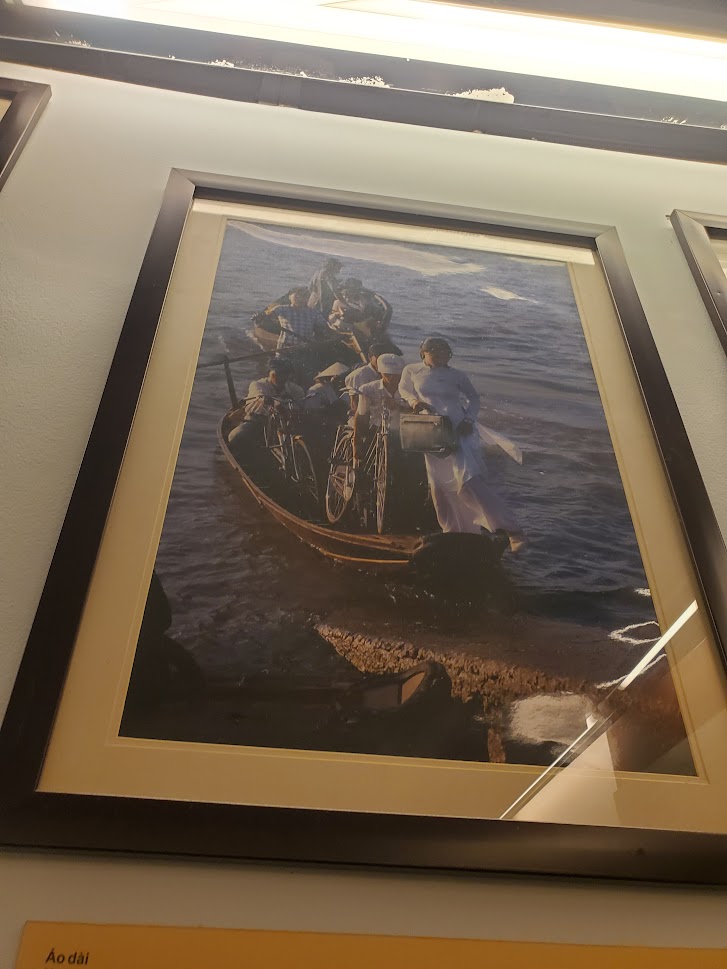

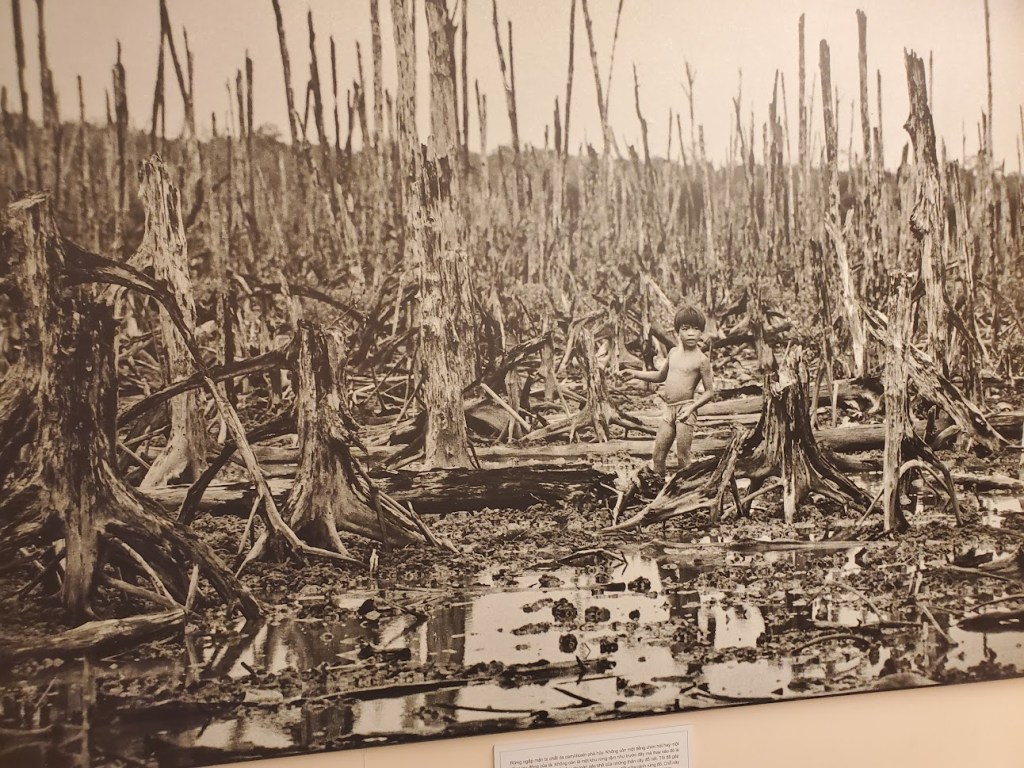
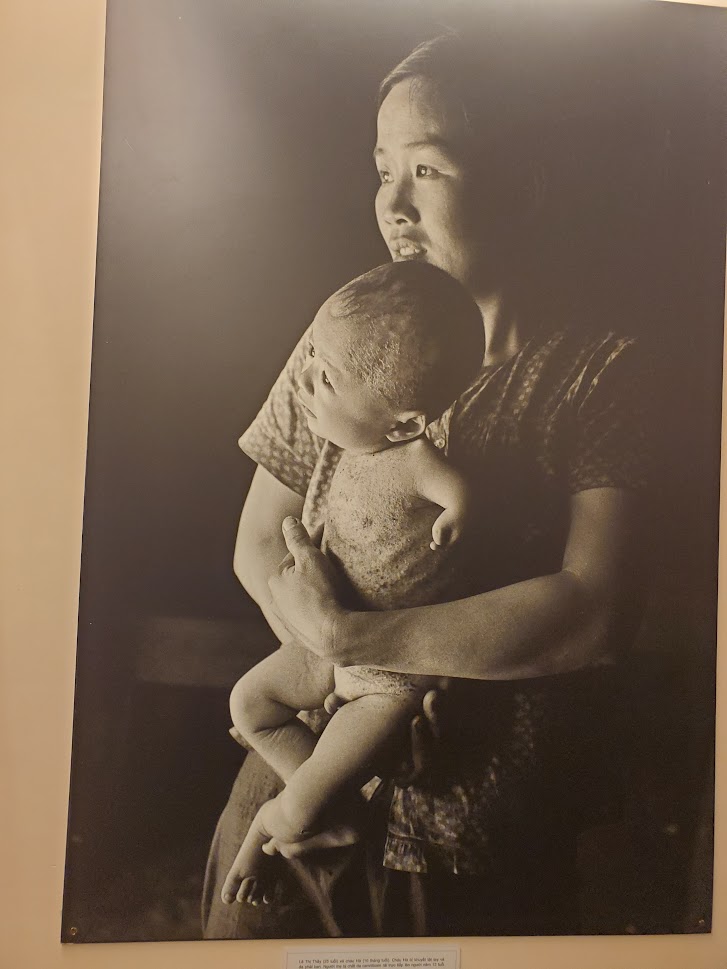
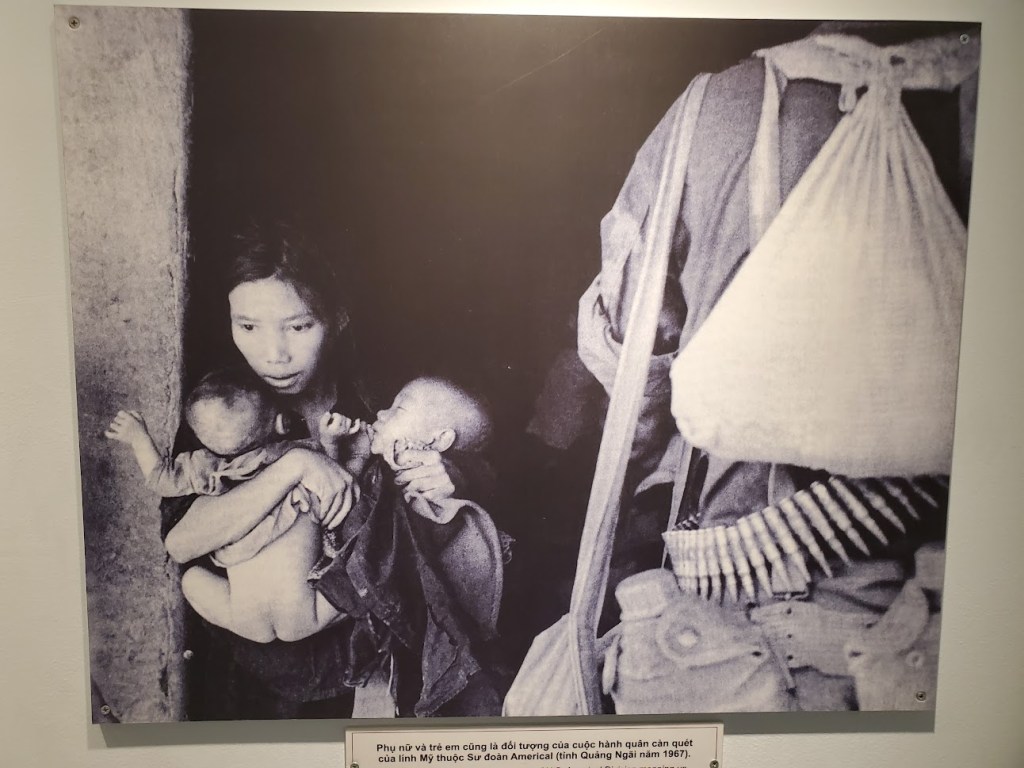
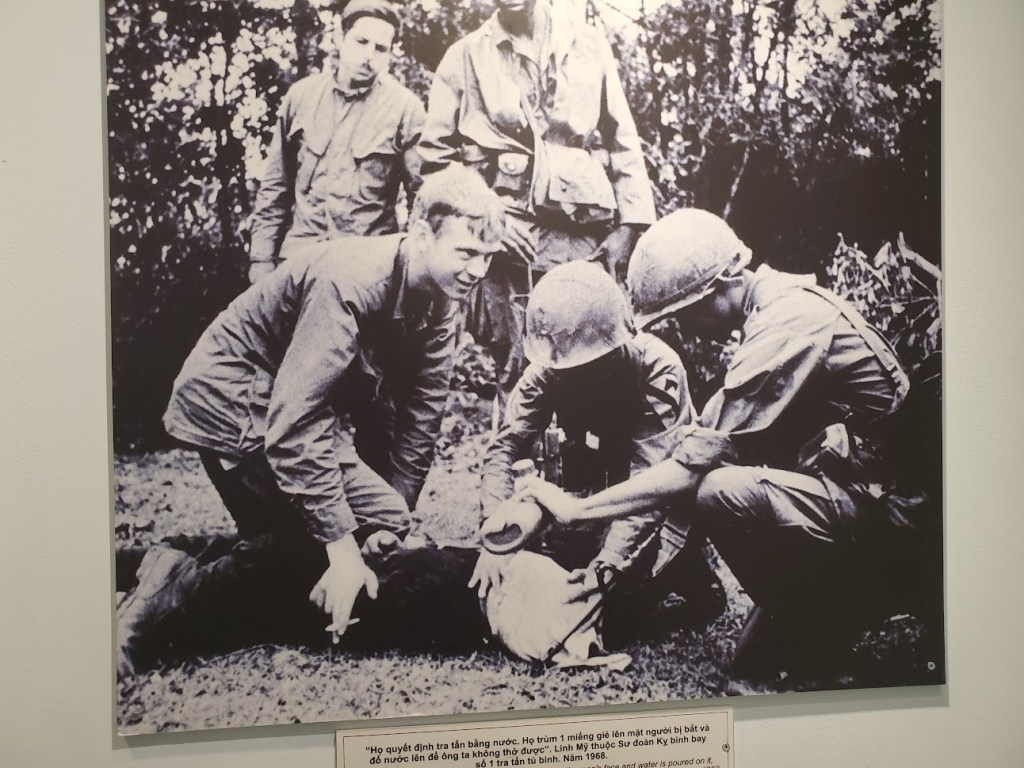
Probably the most difficult photos to see were from the exhibit on Agent Orange. The fact that the effects of that chemical could be passed down to offspring was one that I did not understand. The effects have been documented in third generation descendants of the original victims of the chemical. The chemical companies ended up paying reparations to US soldiers who were incidental victims of the chemical, but no reparations were ever paid to the victims in North Vietnam, or even our allies in the war, South Vietnam.
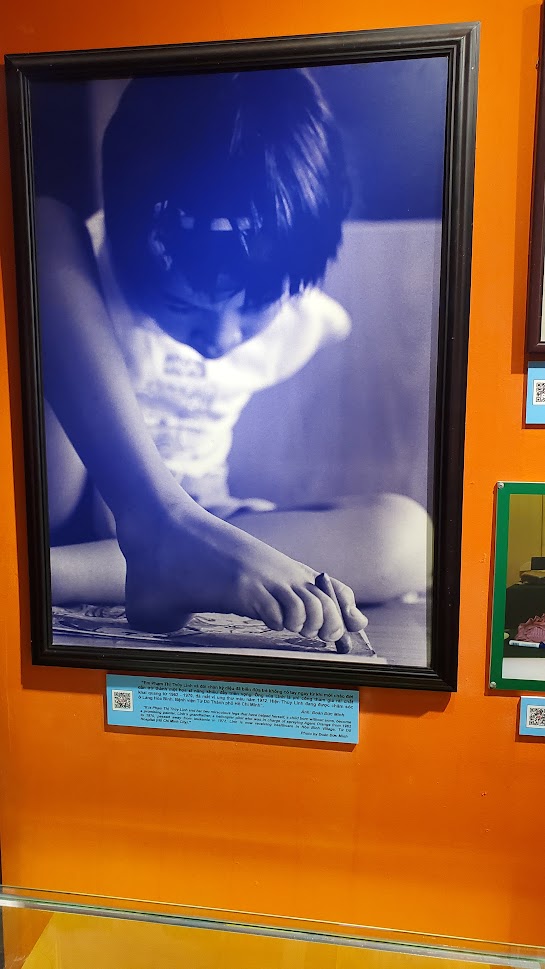
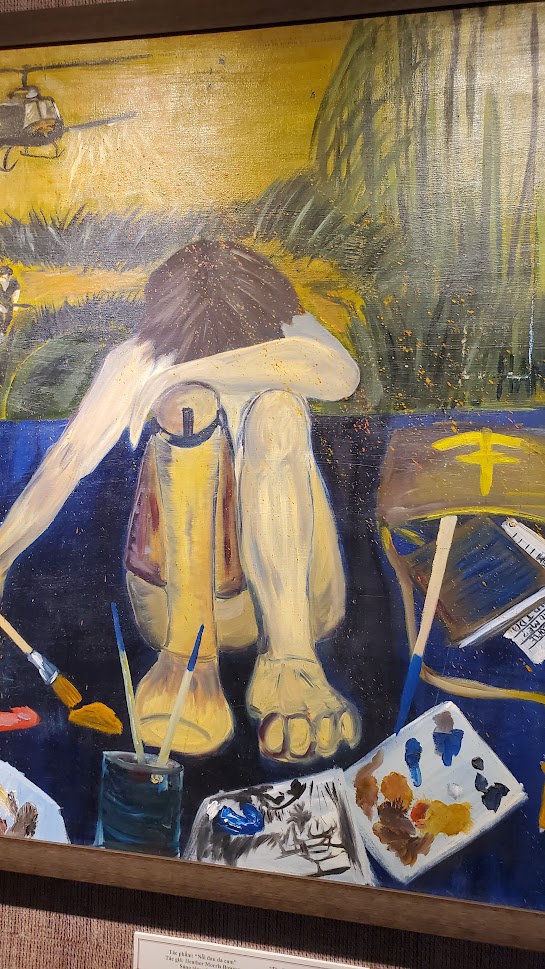
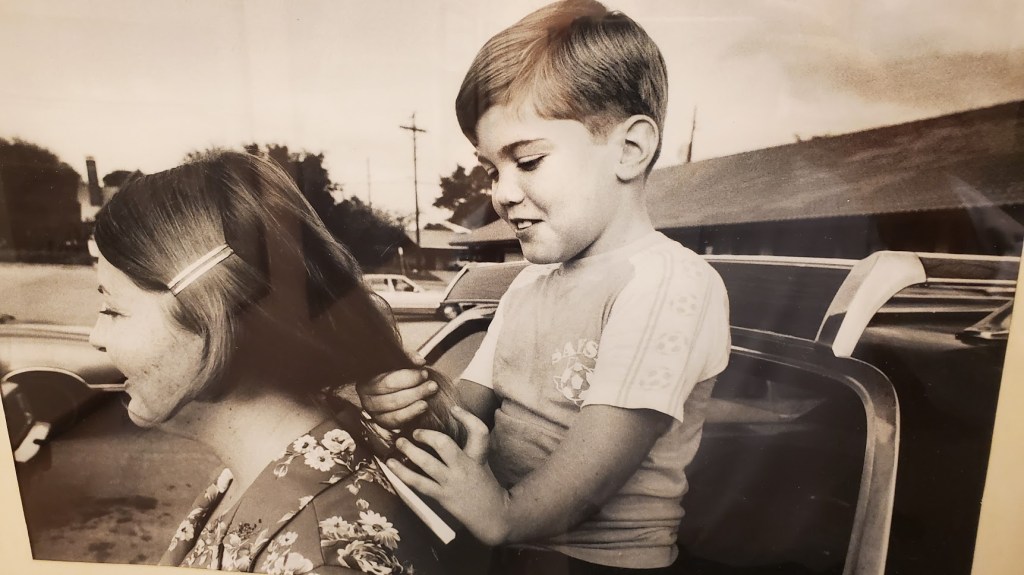

I know these images are hard to view. I also want the reader to know that these are certainly not the most gruesome that were on display at the War Remnants Museum. One such photograph that I will not post is an image of a heap unrecognizable of body parts. The caption on that photograph stated, “The making of a free zone: U.S. soldiers of the 4th Cavalry, 1st Infantry Division incinerate and destroy the village of Ben Suc and the surrounding jungle (Binh Doung Province). ‘From now on, anything that moves around here is automatically considered VC and bombed or fired on.’ explained one bulldozer operator.”
In another photo, a GI from the 25th infantry holding part of a corpse which was a little more than a bloody shoulder part of a torso with a head attached hanging down. Below it was a dismembered leg. The caption read, “Soldier holding a part of a corpse of a Liberation soldier killed by a grenade launcher (Tay Ninh Province–1967.”
The Agent Orange room was too horrific–The ecological and human toll is incredible–birth defects are still showing up three generations later. Dow and Monsanto are evil! I couldn’t go in that part of the exhibit.
The devastation and grief were not limited to Vietnamese people. In the photo below, Sgt. Daniel Loney suffered from PTSD and cancer as a result of his exposure to Agent Orange. In this photo, Loney is shown with his 14-year-old daughter. Due to the agony of living with cancer and PTSD, Sgt. Loney shot himself with a gun in 2003.
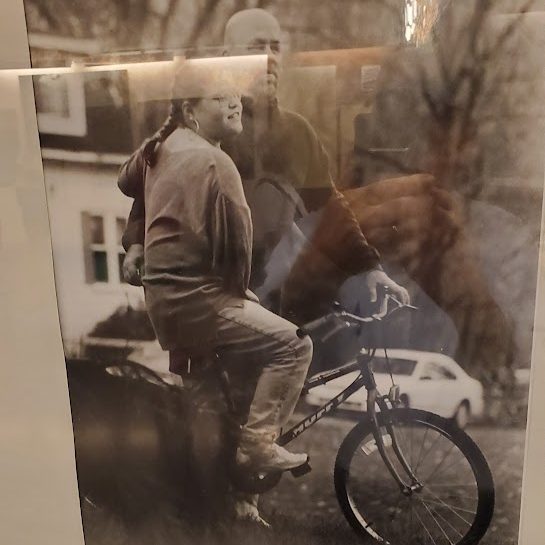
I must say that I know many people who faithfully served and fought in the war with pride. They accepted the call of duty and heroically served their country. They understood that the threat of Communism was a danger and that it needed to be stopped. And indeed, after the US withdrew, the North did come in and take revenge on soldiers that fought against the North. Some were sent to “reeducation camps” as a retaliation for having resisted Ho Chi Minh’s movement to keep the country united. A form of Communism was established for a time. Today, however, the government that still calls itself Communistic is for all intents and purposes, a free society, holds democratic elections, and promotes free trade and capitalistic policies. So, one must ask, what purpose did the war serve?

One friend who served in Vietnam says that it was no place for a young man. He still has nightmares about it and describes in a way that makes me feel that I really have no idea what it could have been for a young man to experience that level of violence, blood and slaughter. While I am glad that I was not subjected to this kind of terror, I am sorry that I can’t fully sympathize with him.
Many soldiers who were ordered to do things that they could imagine themselves doing to another human or were forced to endure and witness things beyond their worst nightmares. For these soldiers, they are the victims of war, every bit as much as those who were wounded or killed.
The museum also showed the other side of the support for ending the war. In one part of the exhibit, a collection of photos shows many young men who resisted the draft and even soldiers who protested the war. It showed efforts of those who fought in the war who came back to lead others in anti-war efforts, like the Vietnam Veterans Against the War.
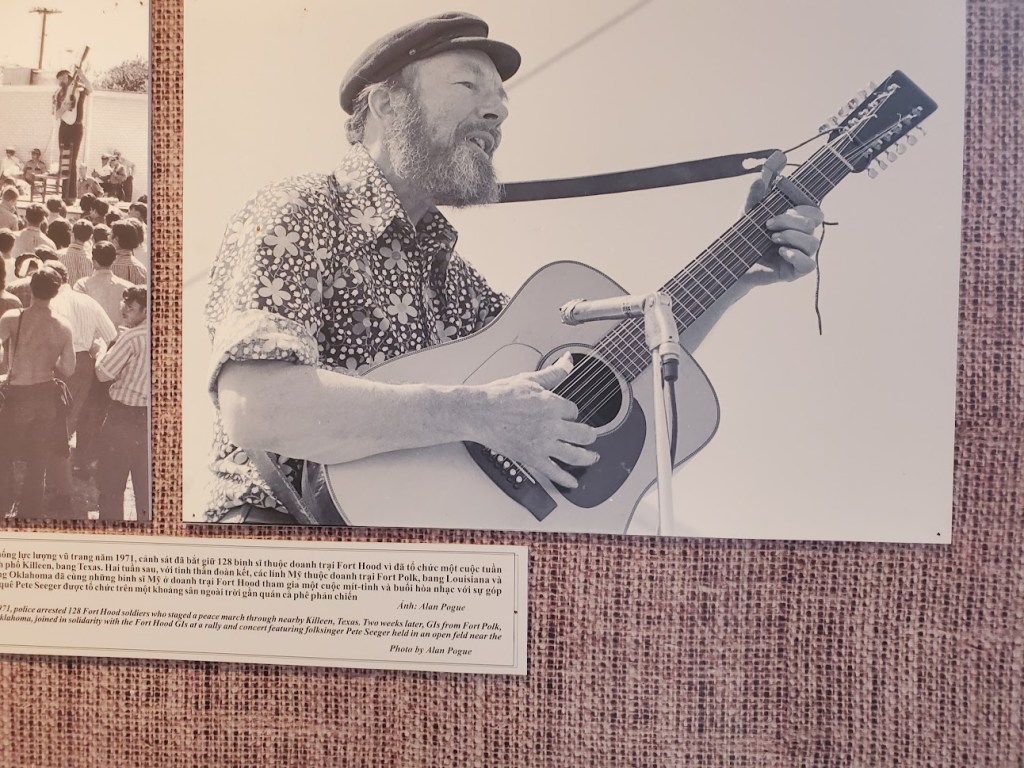

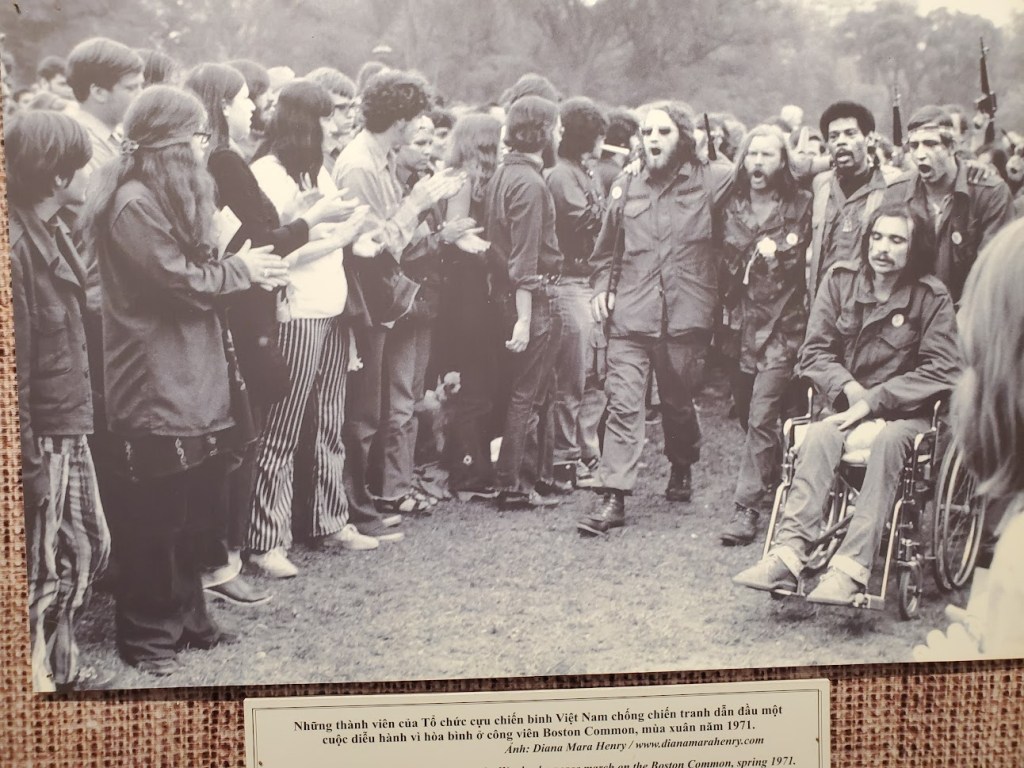

The Palace of Reconciliation
From there, we walked to the Palace of Reconciliation. It was rebuilt after a bombing in 1963 in very much the style of the 60’s. It was airy, with lots of open floors and windows that could open floor to ceiling. It had a bunker in the basement where much of the communication happened during the war.
The building housed the first two Presidents, but after South Vietnam fell, it has been used for receptions and as a tourist venue.
Before and After
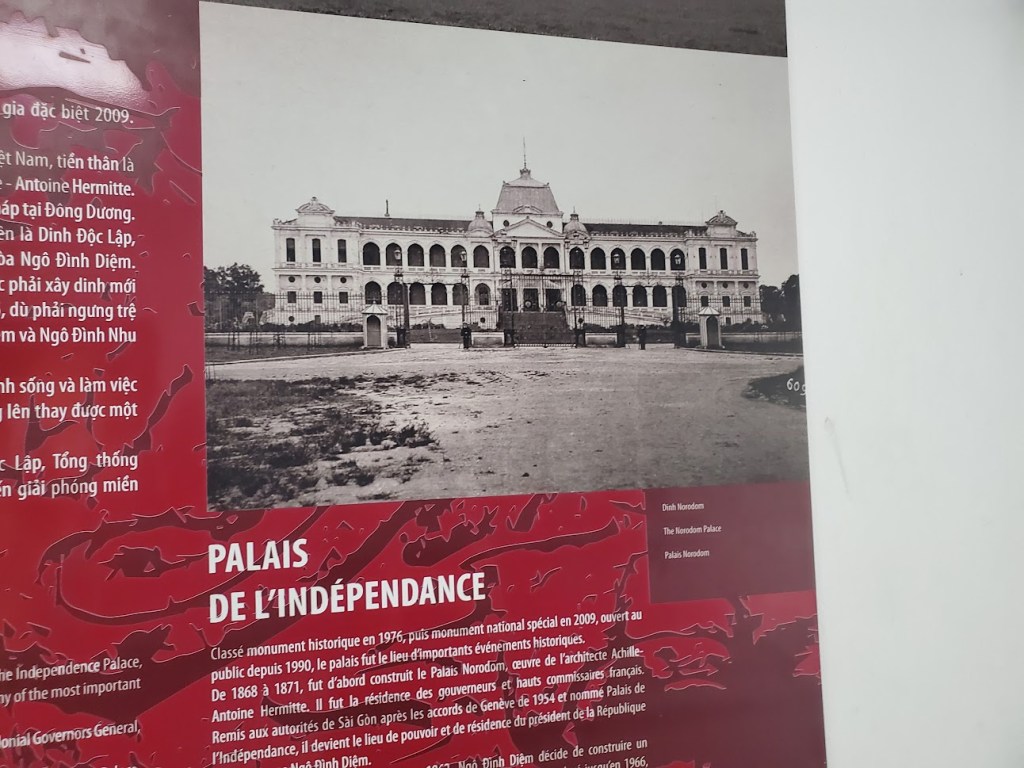

Used originally for entertainment and political receptions, the Palace is now used more as a museum and tourist destination. The rooms show gatherings where some talks between the north and south took place. Some of Rebecca’s photos show the huge kitchen downstairs, and the communications rooms, all very much in the 1960’s era.
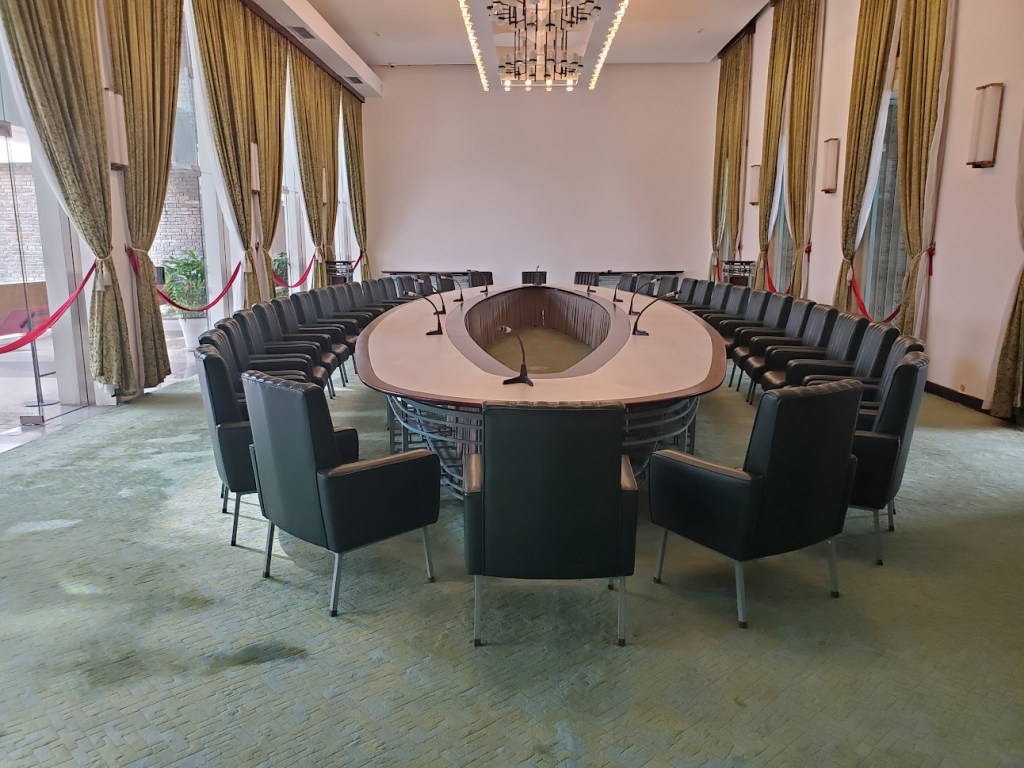
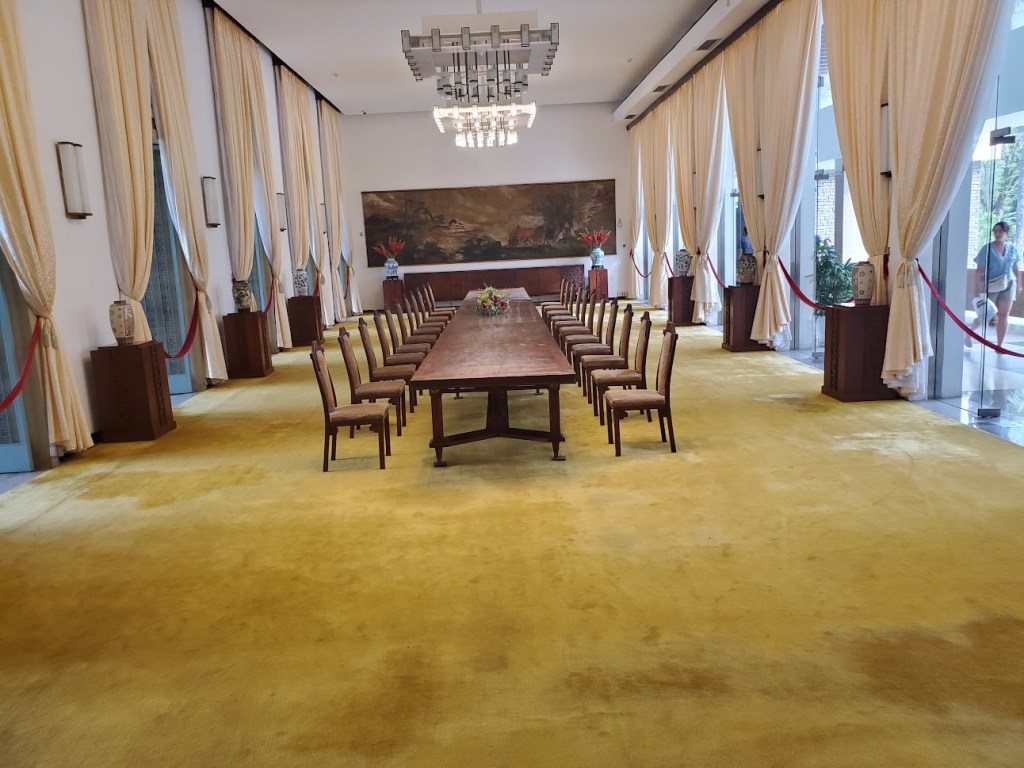
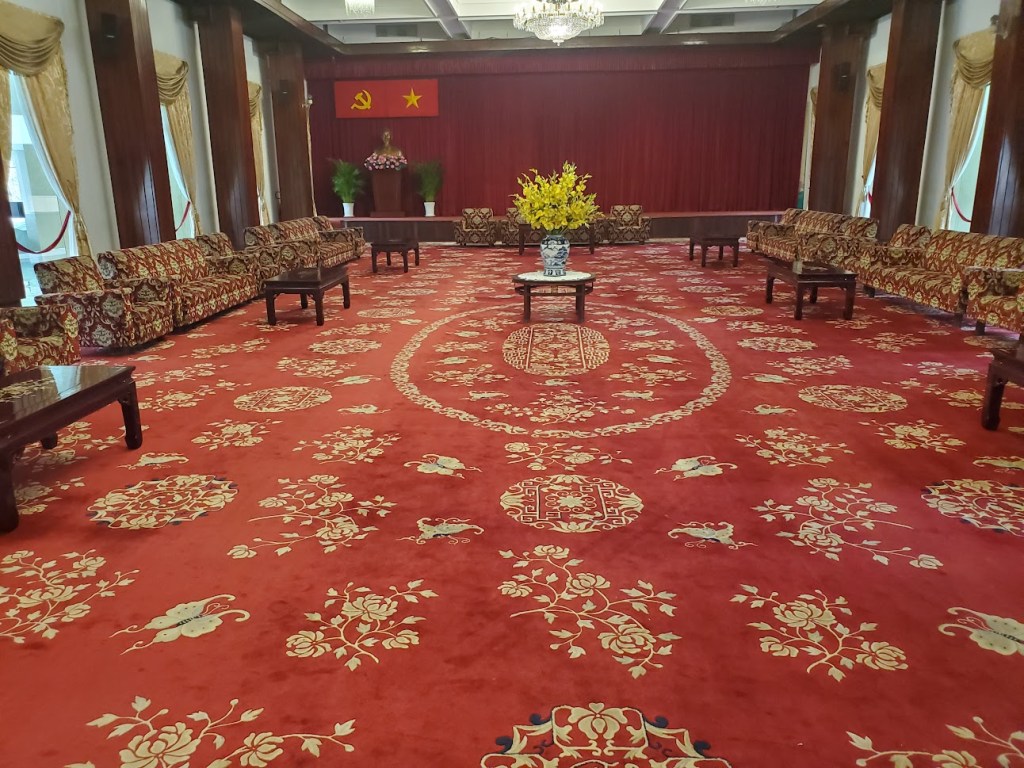

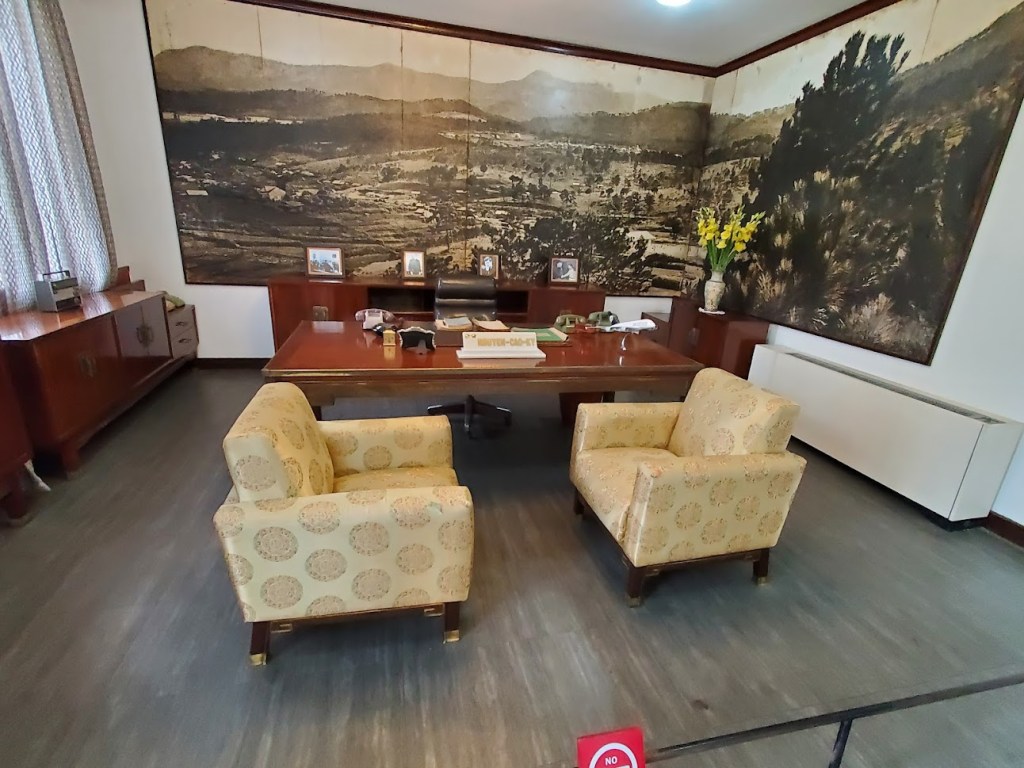
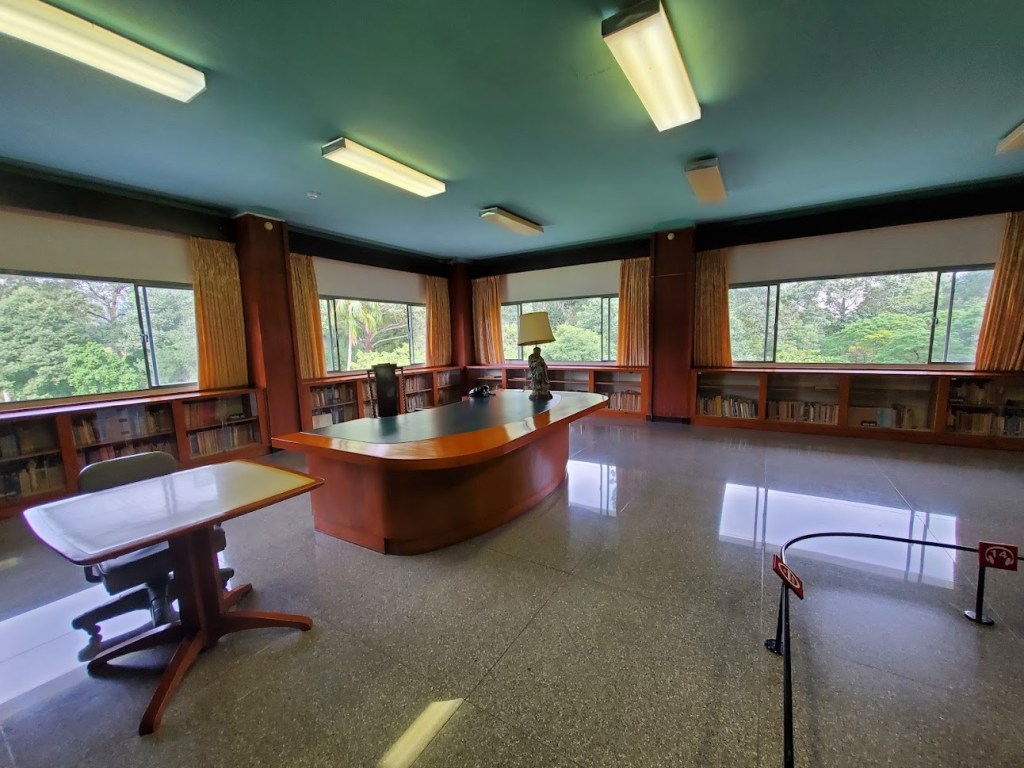
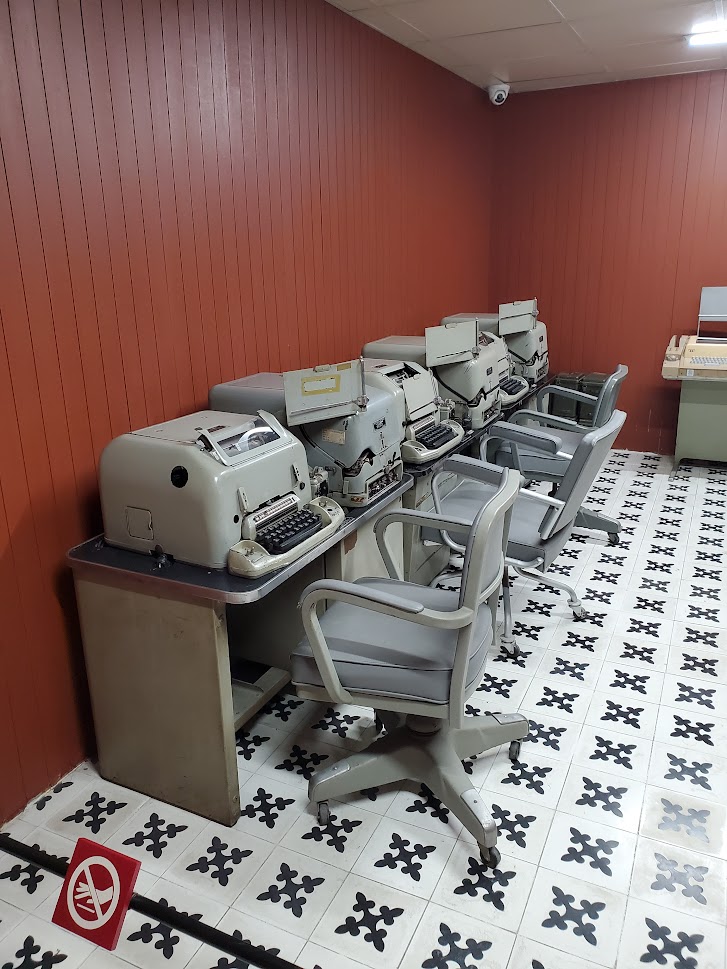
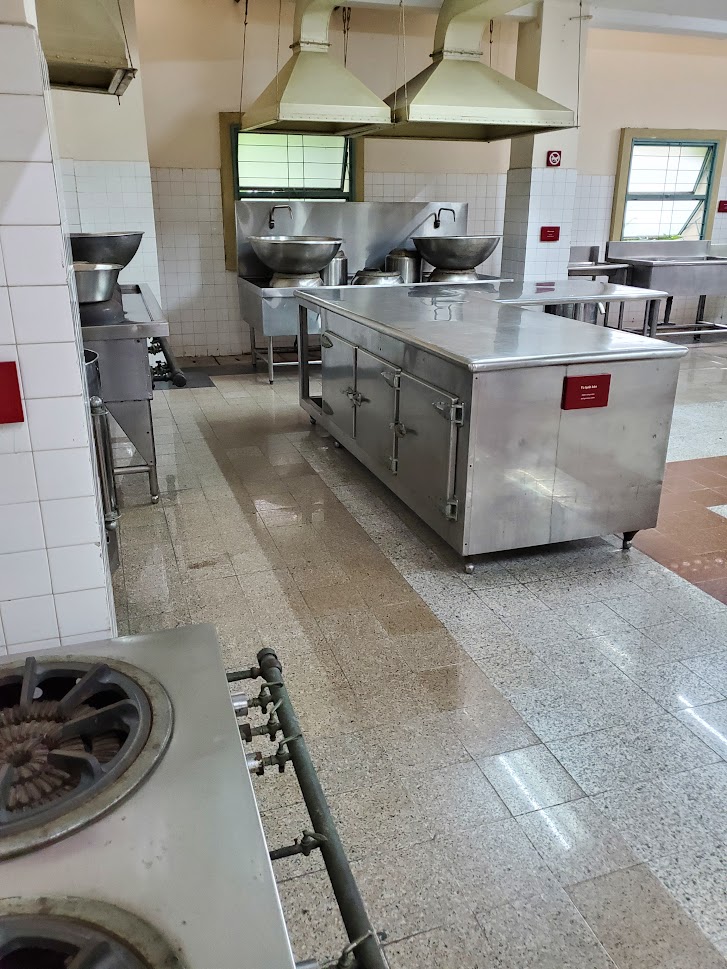

I was not feeling well during this part of Louis’s tour, so I wandered by myself a bit and just sat on a bench and waited for Rebecca to finish the tour. We ended the day getting a drink at a nice rooftop restaurant at Hotel Rex, on the D. Nguyen Boulevard, the main entrance to the government buildings. It was lovely watching the sunset, looking down the boulevard with a view of the Opera House.
We decided to go to a performance at the Opera House. It was an acrobatic show using huge baskets and large bamboo poles. The Opera house was built in the French period and is fine, but quite run down. The performance was lively, and the actors were agile, showing ways of life of the Vietnamese people from rural farmers, the building of apartments, and modern dance. Some stories were funny, some were sweet.
After we walked around the back side of the street looking for a restaurant for dinner. We couldn’t find much, but at cafe upstairs, we had a drink and Woody had a sandwich. Then we took a taxi back.
Cooking Lesson
I woke up early and Woody ordered a cab for me. I rode into town and was dropped off in front of the school alley way. I was the only one in the pace. I was surprised how open the school room was. It was behind the Ho Chi Restaurant where we had eaten our first few days here. The space was open to the street between the wall of the restaurant and the back wall of the court. Several permanent plastic boards covered the top and vines grew along trellises, giving shade.
The tables were set for eight and it was all out and open for thieves.
When we set up the class, the gentleman told me to be here at 7am. I was way too early–no one came until about 7:30 but it was pleasant and I had a place to sit.
Eventually, a very small woman with a lively expression and a purposeful manner showed up and introduced herself as Me. She is our teacher. She apologized for the mistake of the man in the restaurant.
We took a cab to the market where we met the other students. As markets go, it wasn’t the biggest, but I love them, so full of promise.

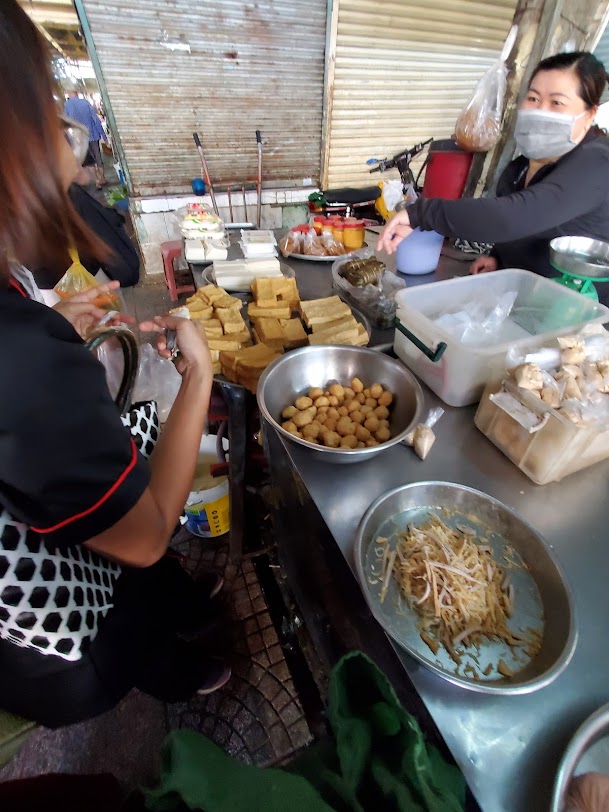
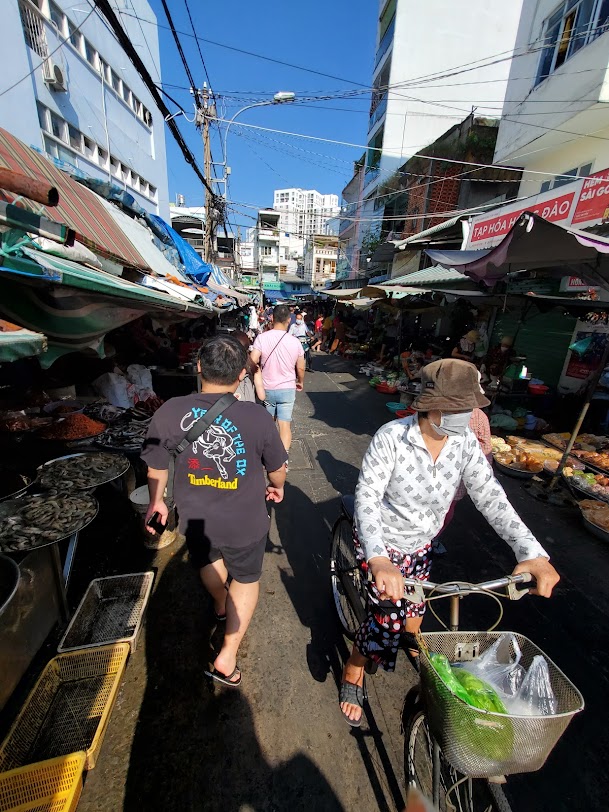

Men and women behind stacks of dried beans and mushrooms or varieties of fresh fruits and vegetables. There were stalls selling socks and underwear and others selling tools. The hard ones for me are the live animals. Fish and eels, chickens and ducks and even frogs.
All the lanes were narrow and croweded with people hurrying to get the produce they needed for the day, but to add to that, they allowed motorbikes in! How crazy was that!? They were going slowly, but still, it added to the confusion.
Me talked about some of the fruits and vegetables and herbs and spices we saw. She bought carrots a green papaya, and mushrooms and herbs.
We all fit in a large cab going back to the school. Two people are from South Korea, two from Taiwan, one from Singapore, and me.They are all friendly and helpful. Luckily, they all speak English.
We sat at a rough wood table and had a cutting board, a large peeler, a grater, and a large knife in front of us. Several small dishes of spices and such were within reach.
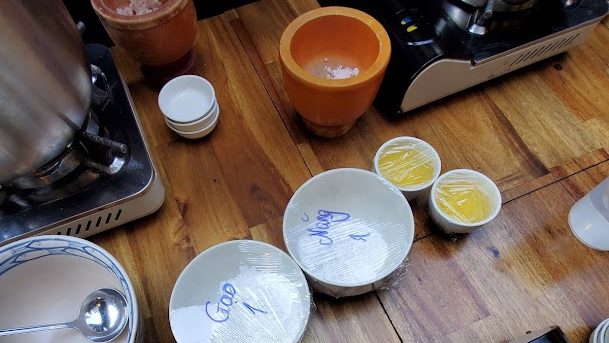
Our first dish was a to make the ubiquitous, sweet sour sauce, mixing sugar, water, chopped garlic, fish sauce for them, a vegan version for me (made with pineapple, soy, and lime), and more lime and chilies.
Then we made a rice flour tapioca steamed pudding, topped with tofu (shrimp for them). We steamed them till they cooked solid.
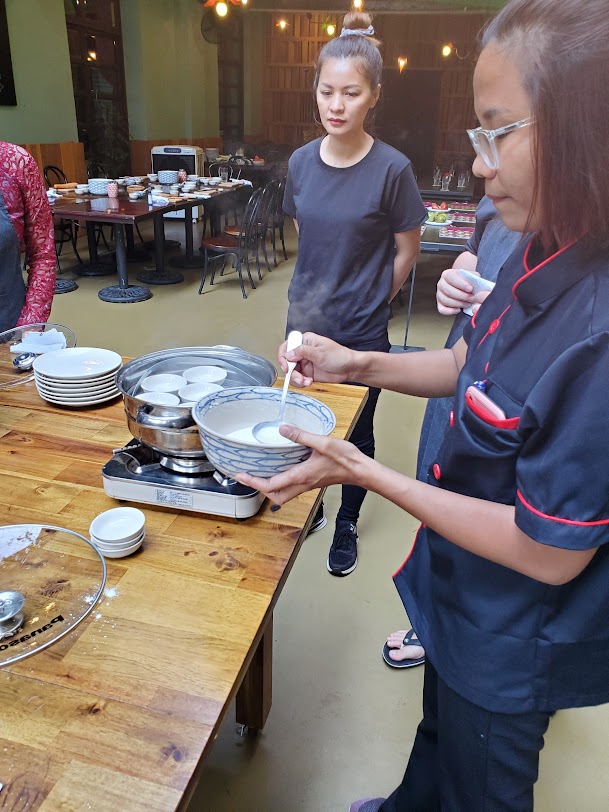
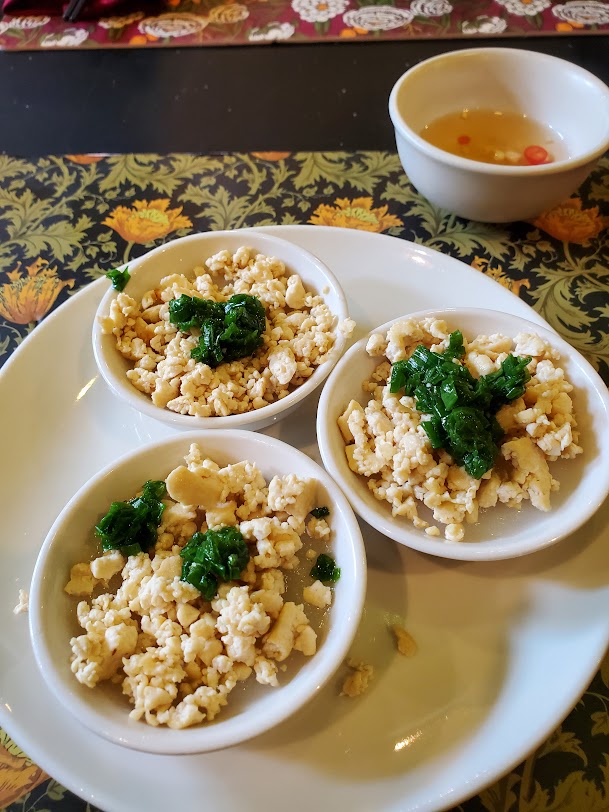
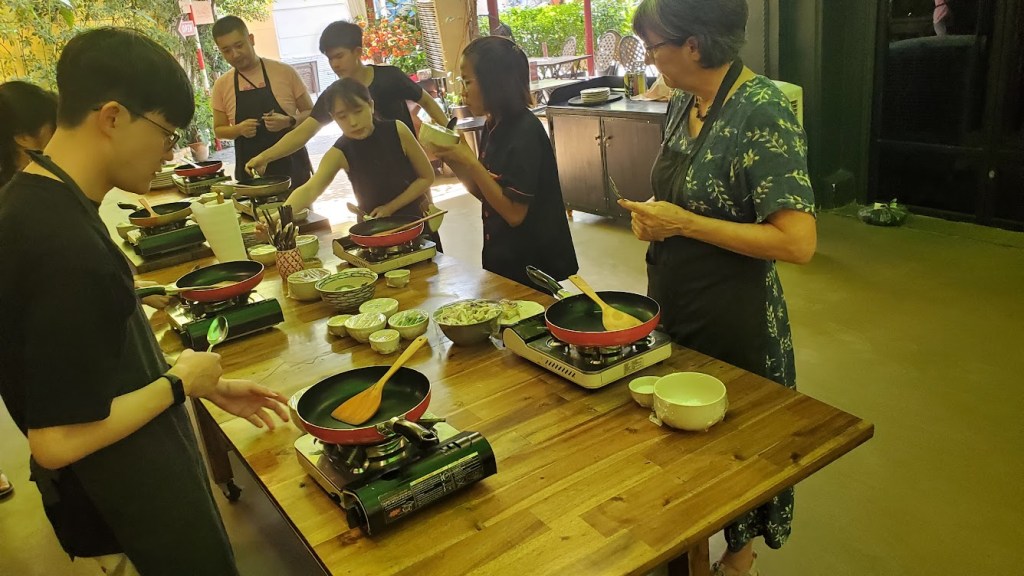

Between each course, our teacher, Me, served us some of the unusual fruits–the first was my favorite, but I didn’t write down the name.
We sat down at a table set for dinner and ate our first food.
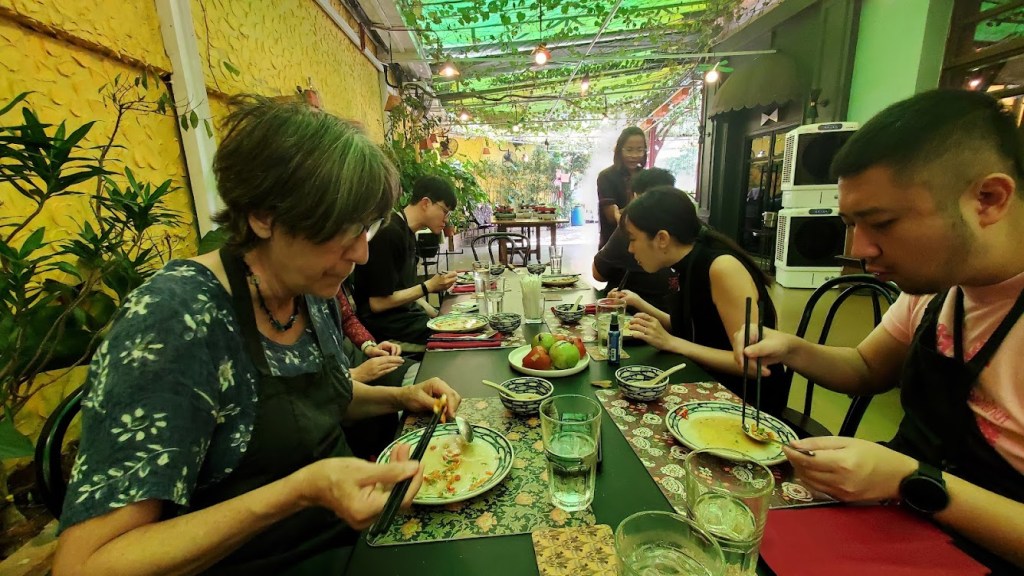
Three helpers kept the palce neat by picking up the dirty dishes and cleaning up our mess.
Next, we made the mango salad with another batch of sweet chili sauce. We sat and ate that too.
Woody came and watched the last session which he filmed some of it. This was a Vietnamese pancake; it, too, was a mixture of rice flour and other ingredients.
Woody joined us when we sat down to eat. We were given a dessert pudding made of purple corn. At the end we got a little booklet that had the recipis and a complemetary coaster.
We walked out to the street and Woody started chatting with the couple from Taiwan. He arranged to meet them for dinner or drinks the next night. We really had no plans, so we just wandered. I suggested that we find the hotel where we would be meeting with our tour group for the next part of our journey, so we wandered that way guided by Google maps.
The couple from Taiwan met us for dinner the next night. We decided to invite them back to the Hotel Rex, with the great view. We decided to meet early so we could enjoy the sunset. When we arrived, they were already there.

The couple from Taiwan are Yanpo and Momo. He works for an adhesive company that makes glue for shoes–Rebok, Nike, etc. She works in IT and develops aps. They have known each other since 4th grade. He works here in Vietnam full time for a year, and she came to visit him.
The waiter we had was truly unctuous and servile to the point it was creepy. It also took forever to get waited on, get our drinks and our food. We hadn’t realized that Yanpo had already ordered everything. He ordered all vegetarian, which was kind of him, but I felt that it was bad for Woody. WE met them about 5pm and didn’t leave the restaurant until nearly 10. That is how long the service took. But it was fun to get to know them–they are both sweet and love Taiwan. They gave us many reasons why we should visit: beautiful city with an 88-story building in the middle, great beaches, great food, kind people, and lovely mountains.


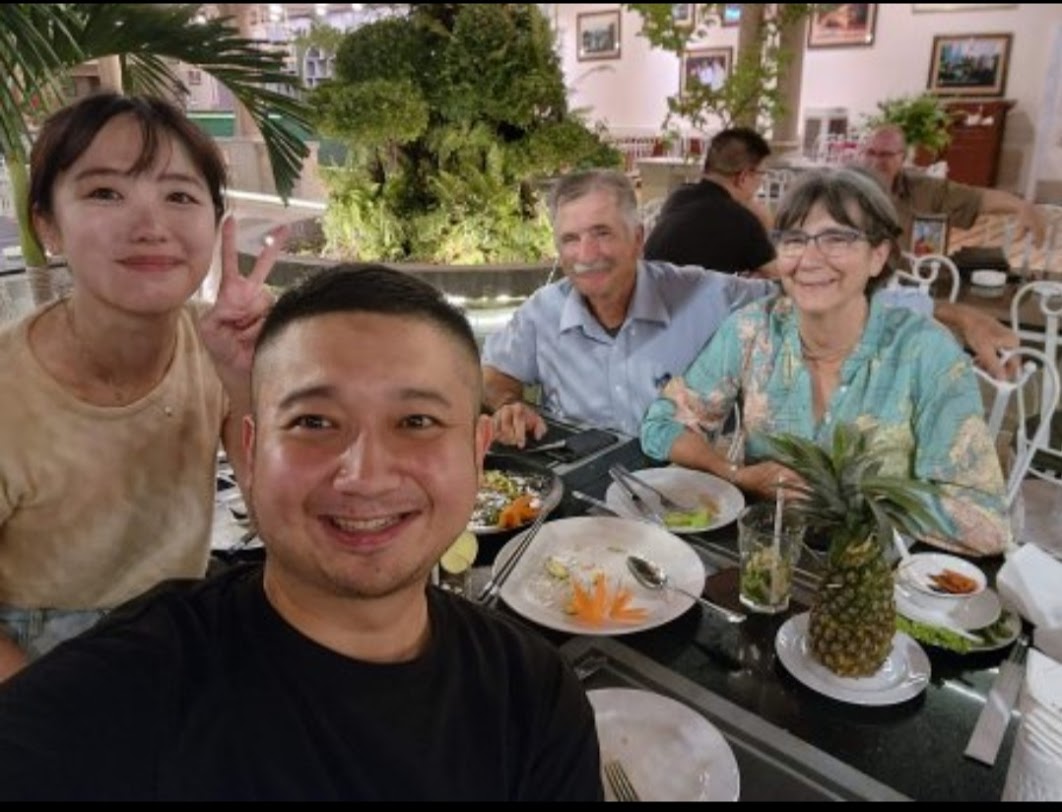
I was interested in learning their views of Vietnam. Yanpo was very enthusiastic, Momo, not so much. He said that the economy is very good for businesses, (which was why his company and the companies they serve are located here.) They both said that they love their homeland of Taiwan, but they like the variety of food here in Vietnam. They said that most businesses seem to like Vietnam because of the competitive cost of living, labor market, and inexpensive housing.
We made some great new friends. They invited us to stop in Taiwan next time we are in this part of the world. I think we would likely find other similar nice people there.
We wanted to get up early the next morning because we were to meet up with our touring group the next day, so we needed to move out of the Empire City emerald towers.
HCMC Summary
Our time in Ho Chi Minh City was coming to a close. I was overwhelmed with the amount of friendship we found among the folks we met here in HCMC… our free guides from “Free Tours,” folks on the street, and visitors from the cooking class. We made some friendships that we hope will continue. We expect to see Tin and Isabella within the next year or so, as they said that they expect to travel to California soon. Although Yanpo and Momo were casual acquaintances, it felt like they would be glad to meet us again if we ever make it to Taiwan.
I was also overwhelmed with the tremendously sad and awful images we saw at the museums. I was really not my intent to heap shame on Unites States’ involvement in the war here, but it seems abundantly clear that the American military actions did not do good, and they did not prevent the bad. That is, it did not prevent “communism” from taking over the country. It also contributed to the deaths of over three million people, both allies and enemies. Besides that, the “communist” government (or more exactly the Socialist Republic of Vietnam) has not turned out to be a malignant growth, or set of “dominos” that would fall, one country to the next. Despite all the fear mongering of the 60’s and 70’s, Vietnam now seems to have all the positive, robust economic energy and competition we have seen anywhere, becoming attractive for businesses and individual investors like Costco, 7-11 stores, Rebok, or Adidas.
Even from the viewpoint of our former allies in the war, we have seen nothing positive about the American involvement here five decades ago. At the same time, Vietnam seems to have recovered from the war, and reunited from the rift after the French occupation, and seemingly forgotten the ill feelings of aggression or abandonment by the United States. After a decade of economic foundering with its initial communist policies, it seems to have adjusted to a full economic partner with the US and promote freedom to pursue happiness and economic success. From the friends we made, great food we ate, and eye-opening images we saw, we had a great introduction to Vietnam.
Next, we head to the middle farmlands and then north to Hanoi. Stay tuned!
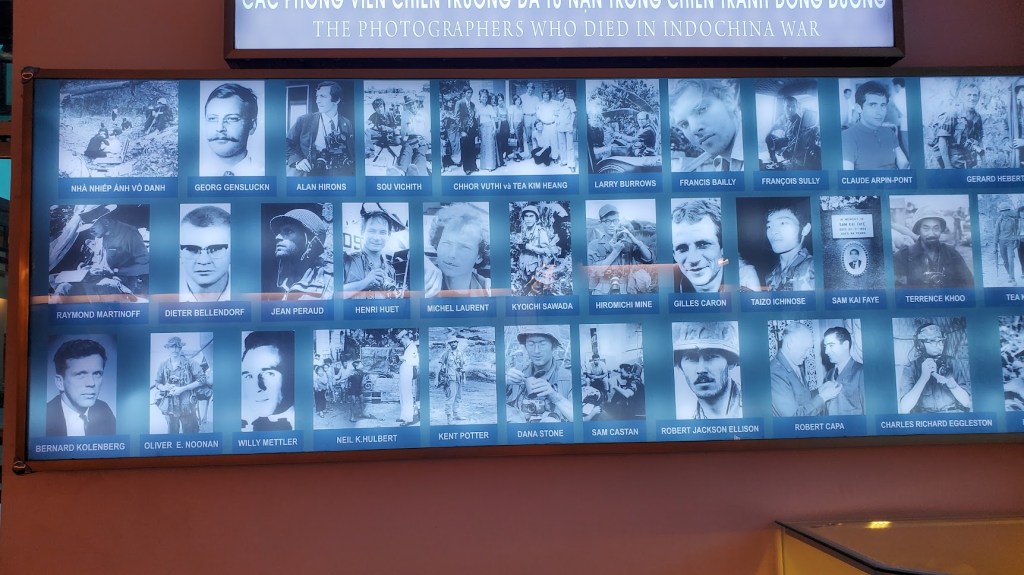

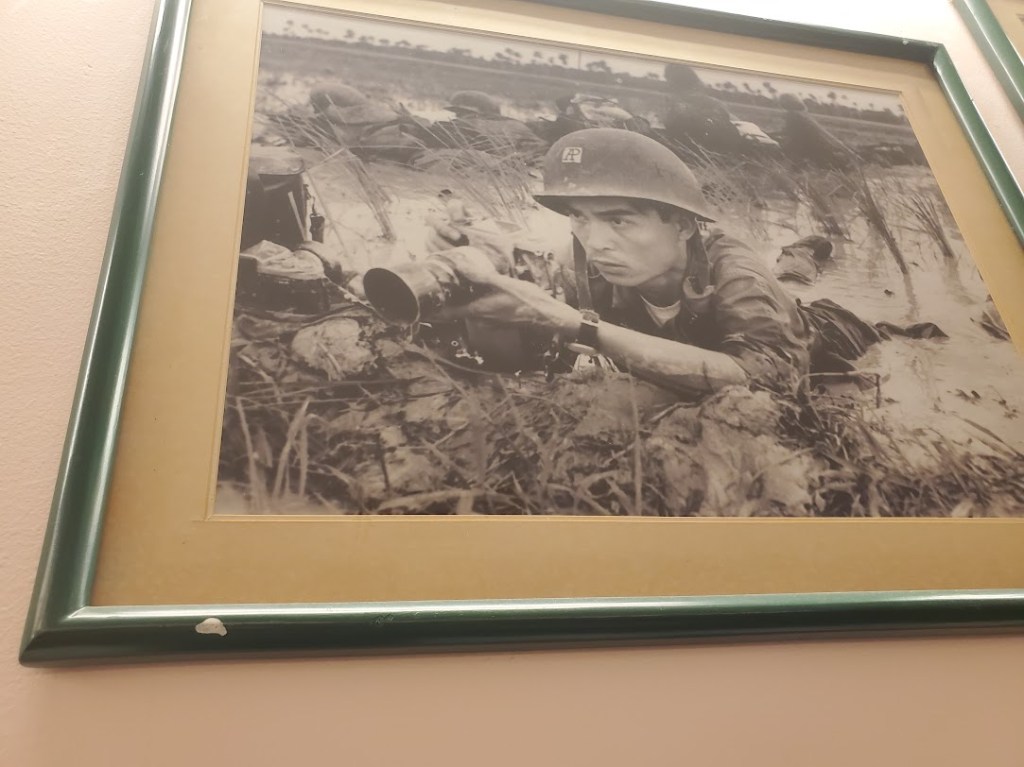

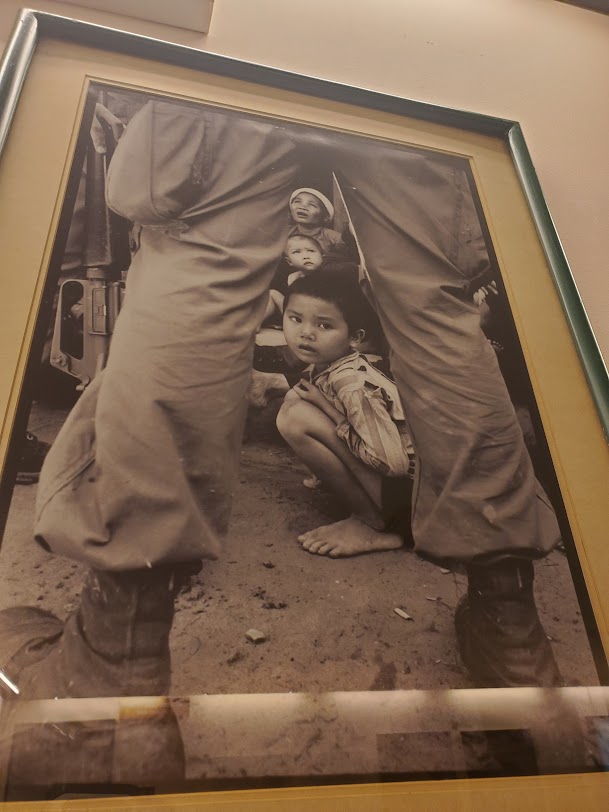

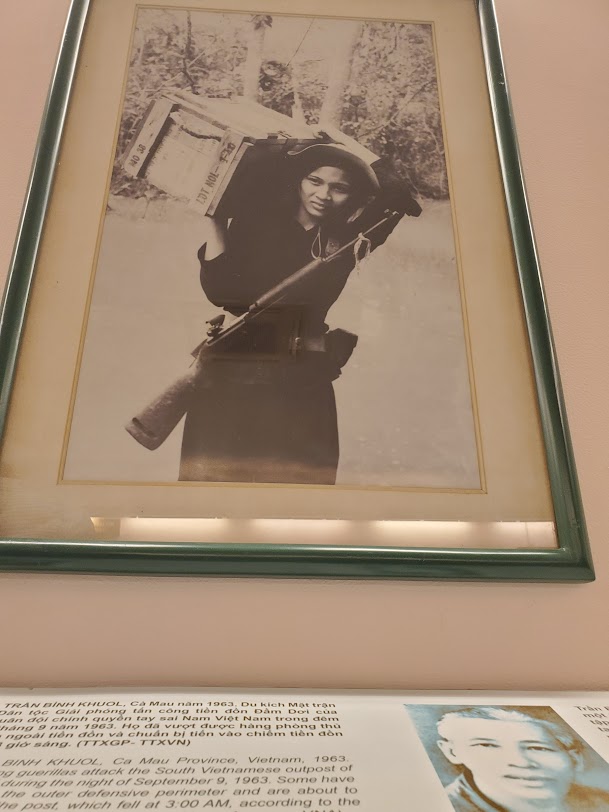
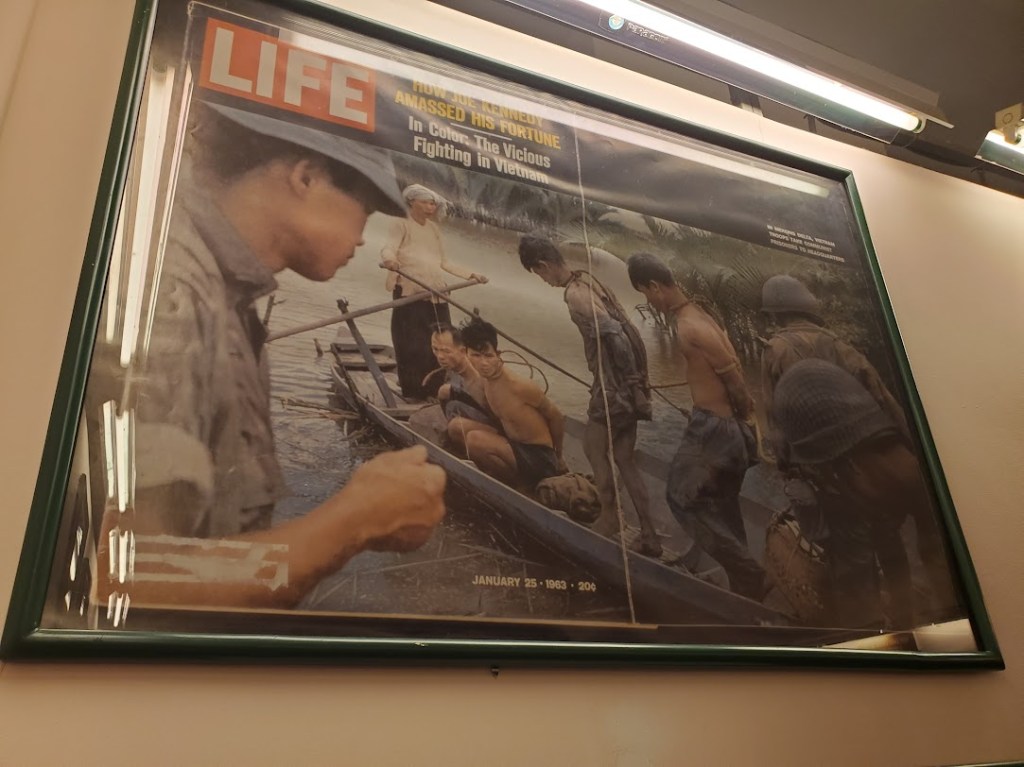
Very interesting travel log. Thank you for your effort in summarizing your adventure and thoughts.
Cheers, Kim
LikeLiked by 1 person
Thanks, Kim, we enjoy writing about our travels. Feel free to share it with others you think might like reading it.
LikeLike
Wonderful descriptions of your experiences in Vietnam. Thanks for sharing.
>
LikeLiked by 1 person
Thanks, Helen! Feel free to share the link, if you like.
LikeLike
Raqther interesting to see your comments on the ‘merican incursion into Vietnam. Spent over a year there as a USAF medic traveling from the Mekong Delta, Saigon, central highlands. Lots of time out there with the local folks so I find the city exposure and tour ride to not be the complete reality as I have known. This being your first trip to SEA I can understand your conceptions being a bit off base from the reality I know. 40+ years (not including military service) living and working in SEA gives me a non-tourist viewpoint. Nevertheless, thanks for the writing of your impressions.
LikeLike
I appreciate your comments. I’m aware of my ignorance and would appreciate your more specific comments. If you feel like it, please comment here, or email me at fridaefamily@wavecable.com. These are just my impressions, and I want to learn.
LikeLike